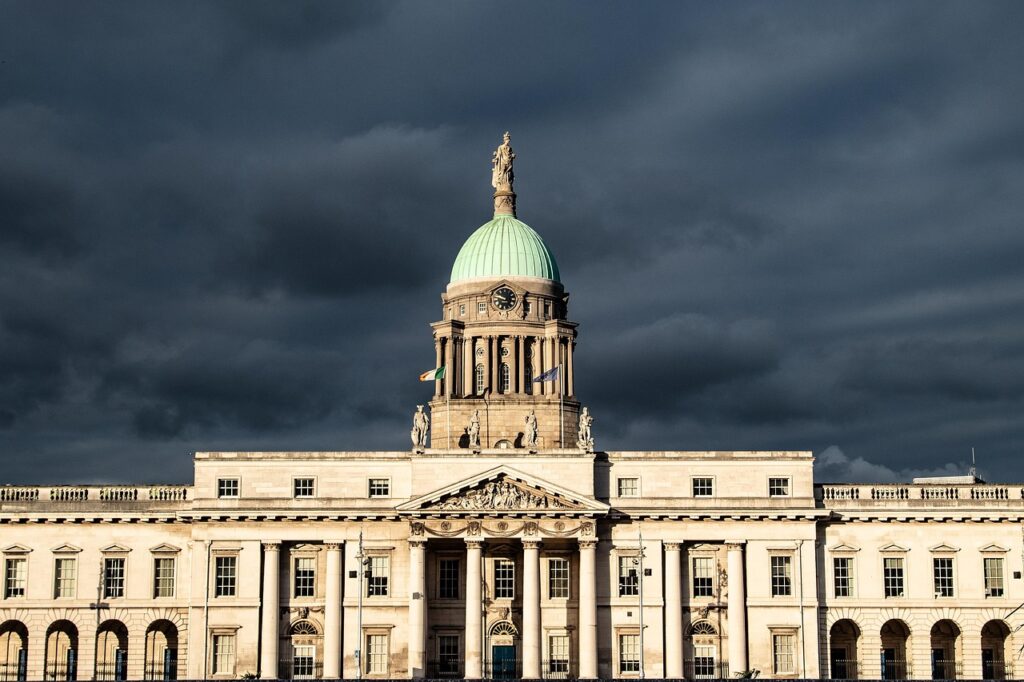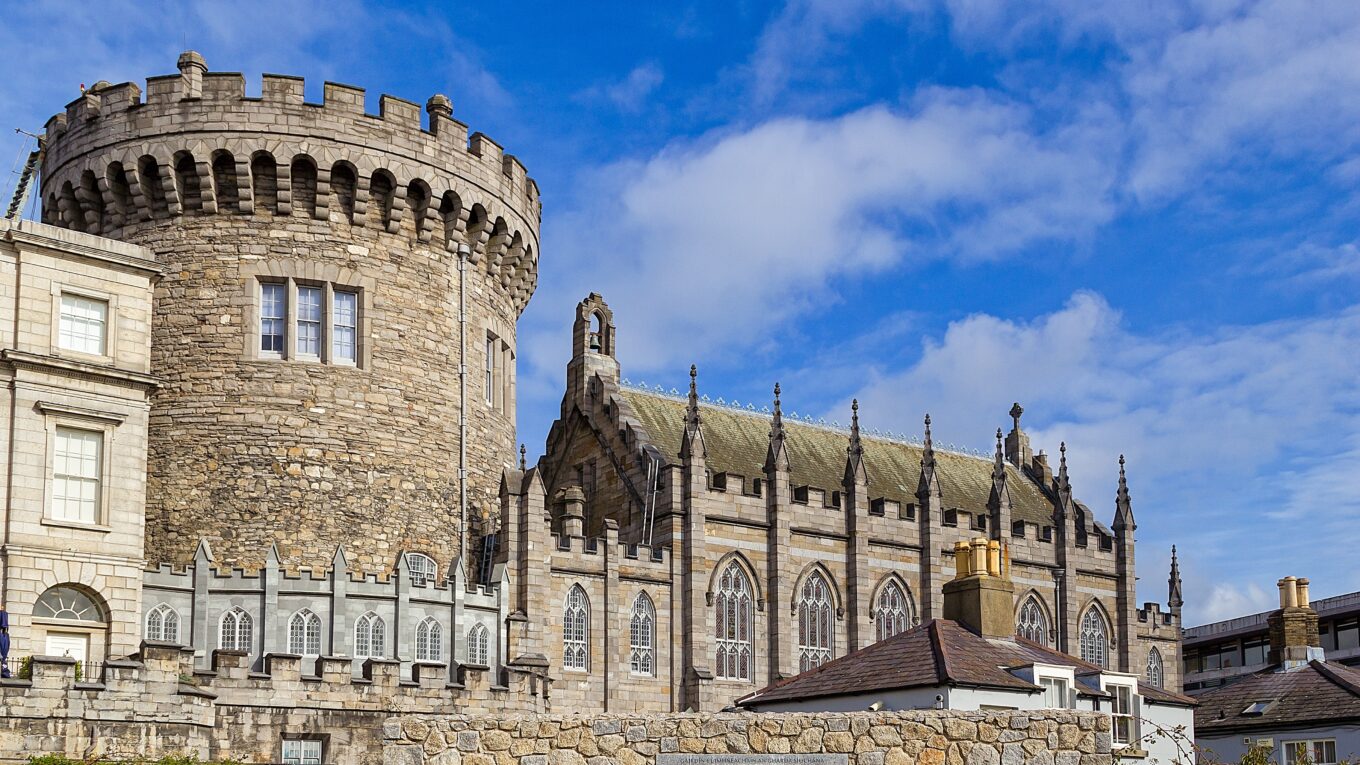Architecture of Dublin, Ireland
Dublin is the capital of Ireland and home to over 1.2 million people. Founded by Vikings in the 9th century, Dublin was later controlled by different factions, including the Normans, the English, and the Irish. Dublin contains several Gothic Churches and Castles and a large assortment of Neoclassical and Revivalist buildings from the 19th century. Modern Dublin has become the capital of an Independent Irish Nation, and the city has seen a huge influx of people, businesses, and tourism. Today, Dublin is a vibrant city containing many modern sites like the Guinness Storehouse, the Jameson Bow-Street Distillery, and several of Ireland’s greatest museums. This article will take an extensive look at the architecture of Dublin, and highlight some of the city’s most notable buildings.
Map of Dublin
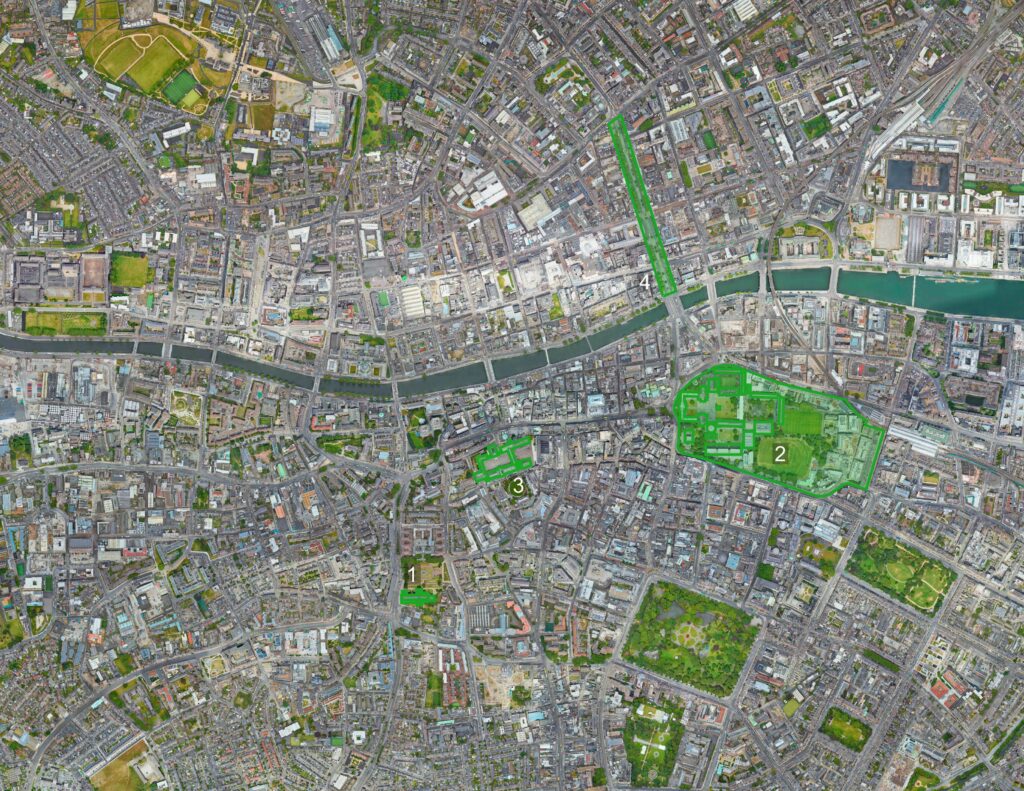
Table of Contents
Use these buttons to navigate to different sections of the article
History of Dublin
Dublin’s Colorful Doors
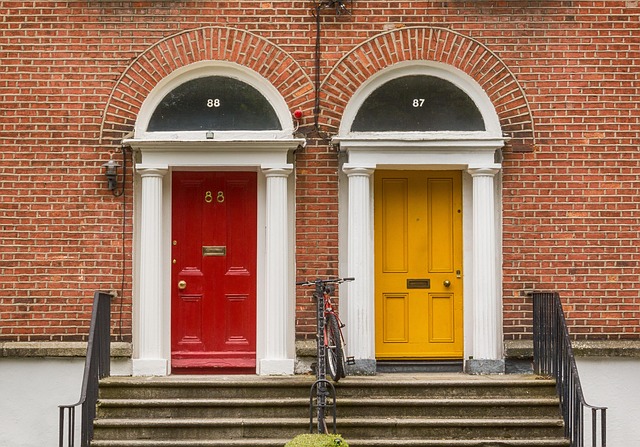
One unique element to look out for in Dublin is the city’s colorful doors. Dublin contains an assortment of vibrantly painted doors, which contrast with the city’s mostly Neoclassical appearance. The colorful doors of Dublin are a unique and quirky trait of the city, and they help connect its various streets and neighborhoods.
Romanesque & Gothic Architecture in Dublin
Dulbin was established as a small Viking settlement in the 9th century. The Vikings controlled the city for several centuries but were eventually pushed out by an invading Norman Army, which departed from Wales in 1169. These new Anglo-Norman invaders would construct several of Dublin’s earliest surviving buildings. They focused on security and religion and began work on several fortifications and churches. These monuments were designed in architectural styles like Romanesque & Gothic, which originated in mainland Europe.
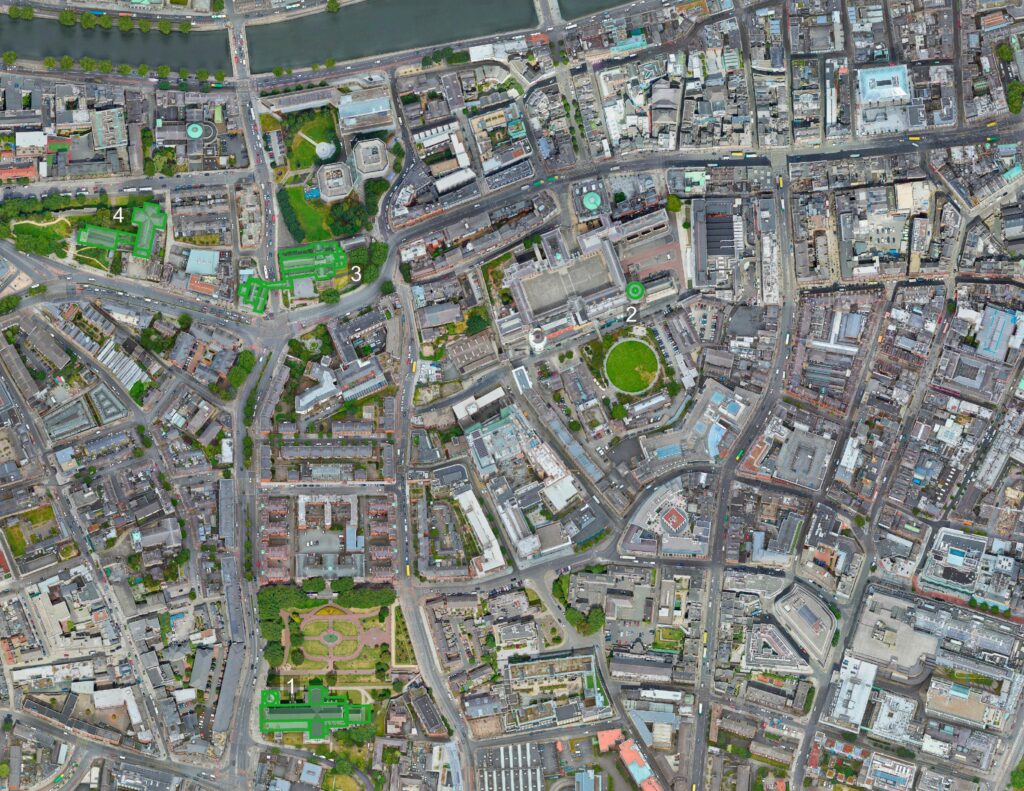
1. St. Patrick’s Cathedral

St. Patrick’s Cathedral is the greatest example of Gothic Architecture in Dublin. Construction began on the building in 1191 and was mostly completed by 1250. The church was, however, expanded and modified over time. The bell tower was rebuilt later on in the 14th century, and much of the church’s interior decorations were altered in subsequent renovations.
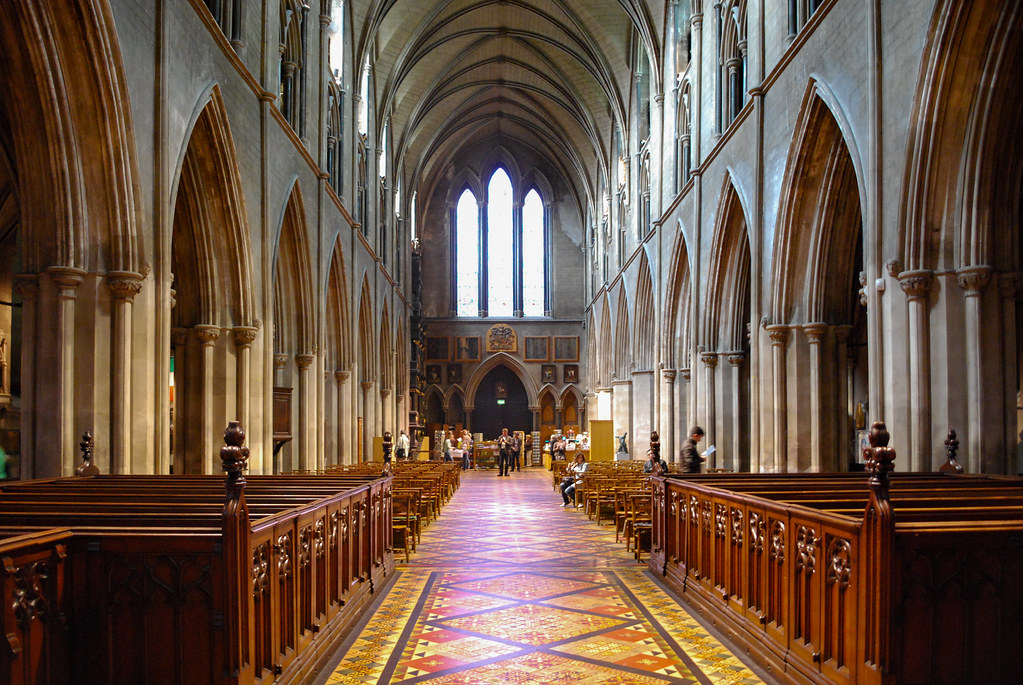
The church is one of the largest in all of Ireland and contains all of the typical elements of Gothic Architecture. The image above shows the church’s nave, which is composed of pointed arches and a tall Gothic groin-vaulted ceiling. The floor of the church is also an interesting work of art. It has thousands of tiles intricately decorated with traditional Irish iconography like Celtic Knots and crests from the Irish nobility.
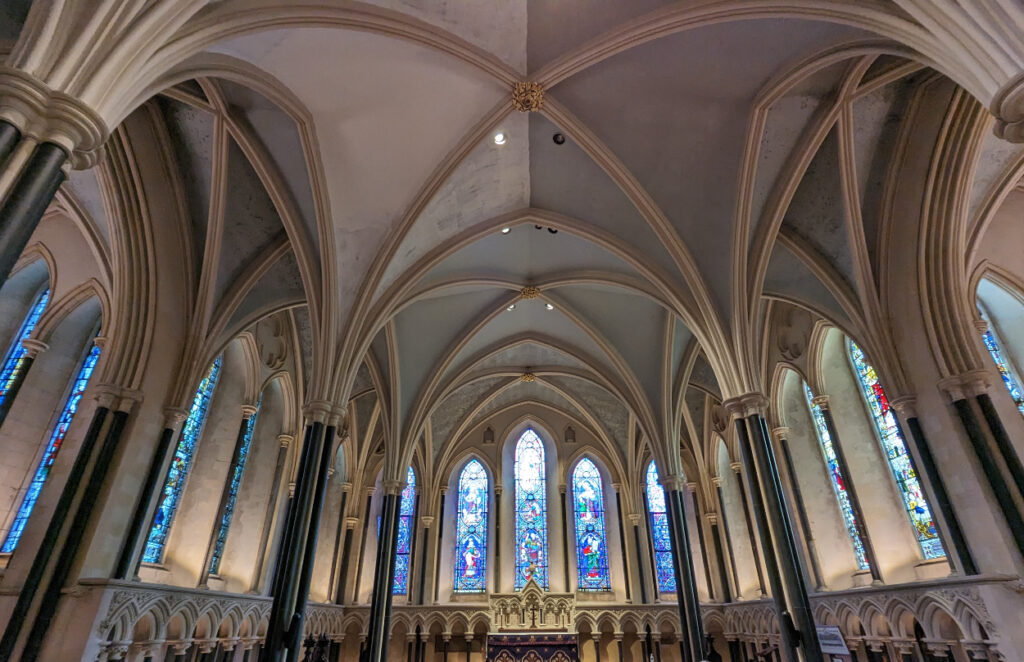
This image shows the Lady Chapel of St. Patrick’s Cathedral. This part of the building was originally added in the 1200s but was greatly refurbished during the 17th & 18th centuries. The Lady Chapel contains some of the best Stained Glass in Dublin. Today, St. Patrick’s Cathedral still holds weekly services and is one of the most cherished buildings in all of Ireland.
2. Round Tower of Dublin Castle
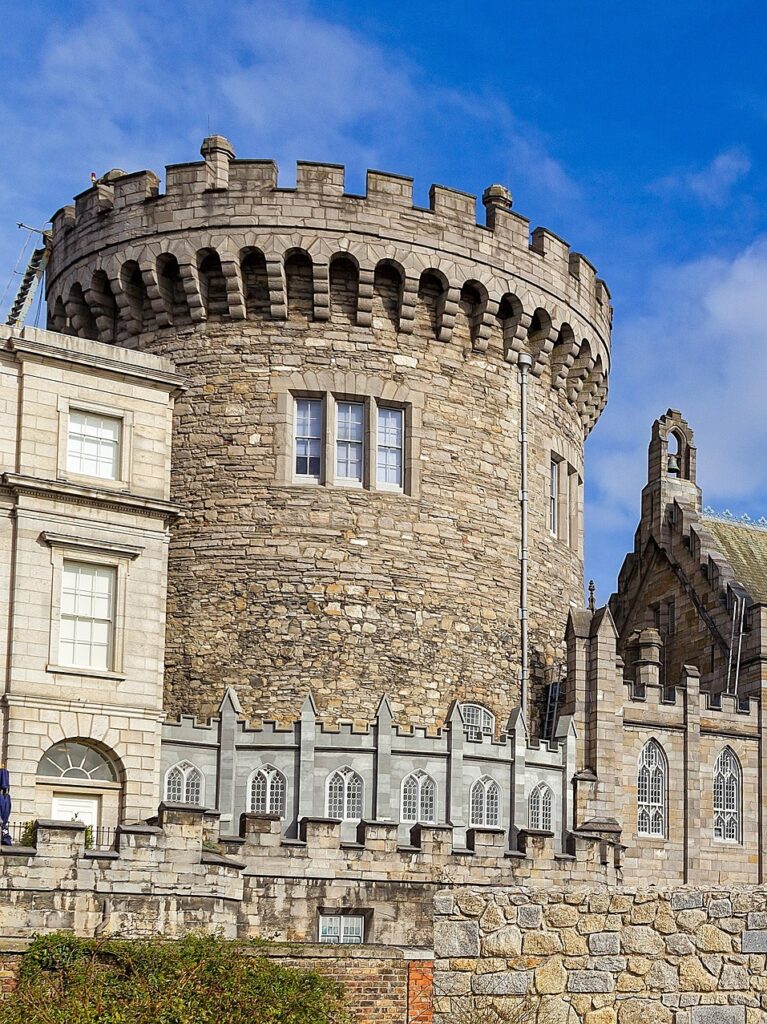
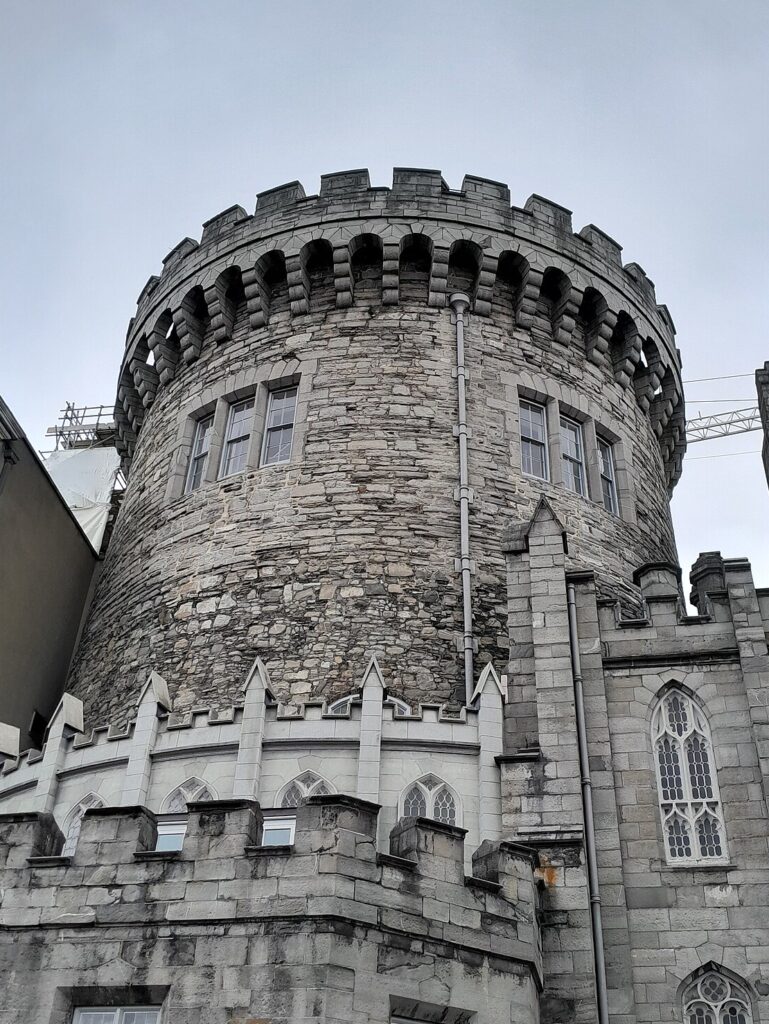
Dublin Castle is a large collection of buildings in the center of the city. The castle’s main round tower was built in the aftermath of the Anglo-Norman invasion of Ireland. The Normans built fortifications throughout Ireland, just as they had done during their conquest of England. The original castle was completed in the mid-13th century and contained an elaborate network of walls, ditches, and fortified towers. These original portions of the building contain elements from both Romanesque and Norman Architecture.
3. Christ Church Cathedral
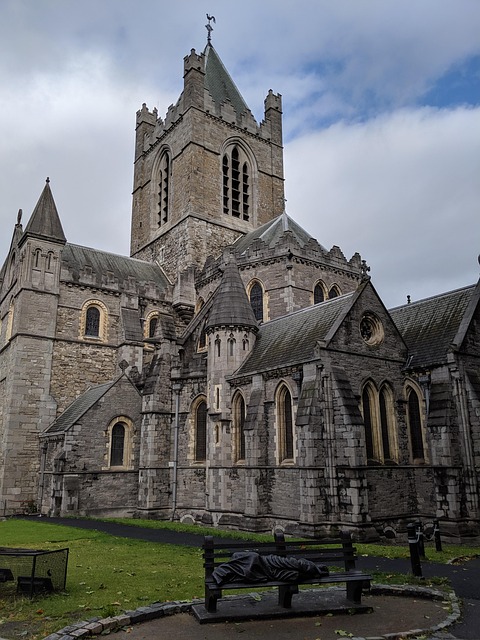
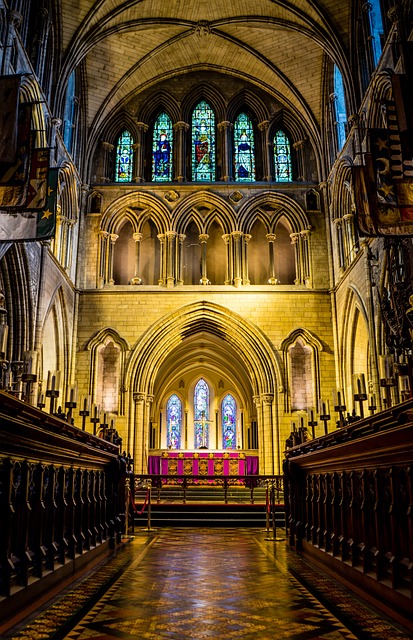
Christ Church Cathedral is another great example of Gothic Architecture in Dublin. The church originated in the 11th century, making it older than St. Patrick’s Cathedral and the Anglo-Norman invasion of Ireland. The church, therefore, holds a special place in the hearts of the Irish people. Christ Church Cathedral was dramatically expanded by the Normans and designed in the same fashion as St. Patrick’s. Today, Christ Church Cathedral is renowned for its stained glass and other Gothic elements.
4. St. Audoen’s Church
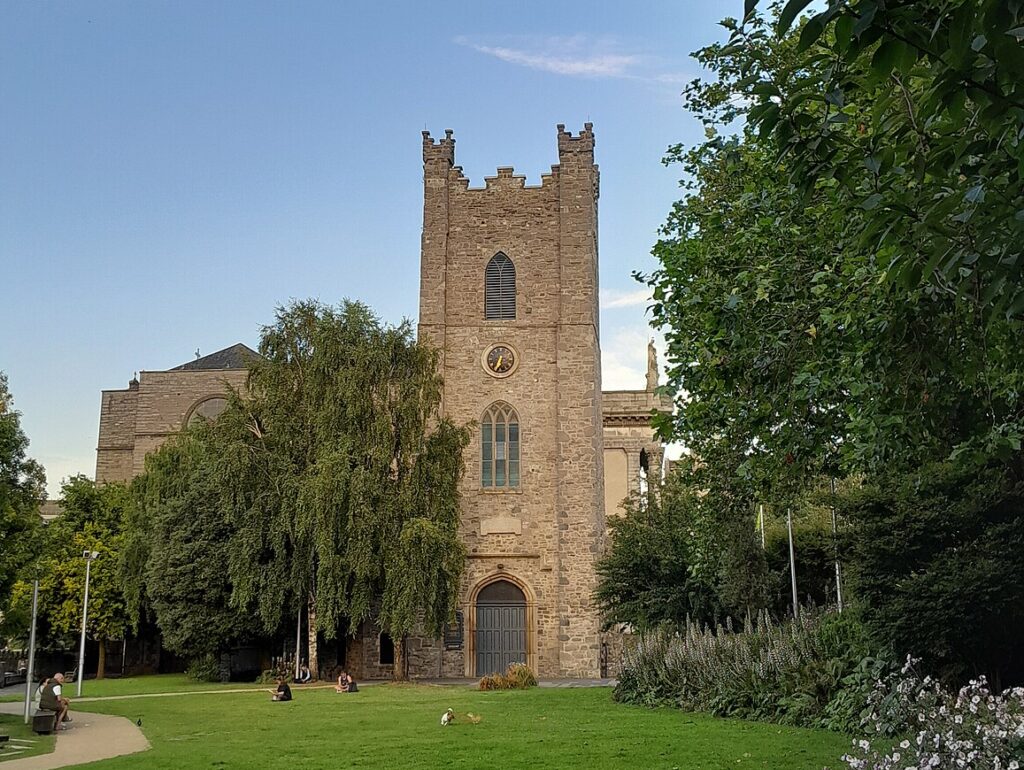
St. Audoen’s Church is another Medieval building located in central Dublin. It was built in the late 12th century and contains several Gothic & Romanesque elements. The church also contains a large addition from the 19th century that was done in the Greek Revival Style. The image above shows the church’s main tower, which overlooks a small green. All of the Norman-era churches in Dublin illustrate how the city dramatically changed during the early stages of foreign rule.
Neoclassical & Revival Architecture in Dublin
Dublin completely transformed during the Georgian and Victorian Ages. Dubin would see a flurry of construction, and dozens of impressive Neoclassical and Revivalist buildings were completed throughout the city. Trinity College was greatly expanded at this time and outfitted with many new monuments and structures. Several prominent roads were also constructed, which helped Dublin expand outward from its Medieval Core. The most notable of these is O’Connell Street, which is lined with many townhouses built by Dublin’s wealthy families.
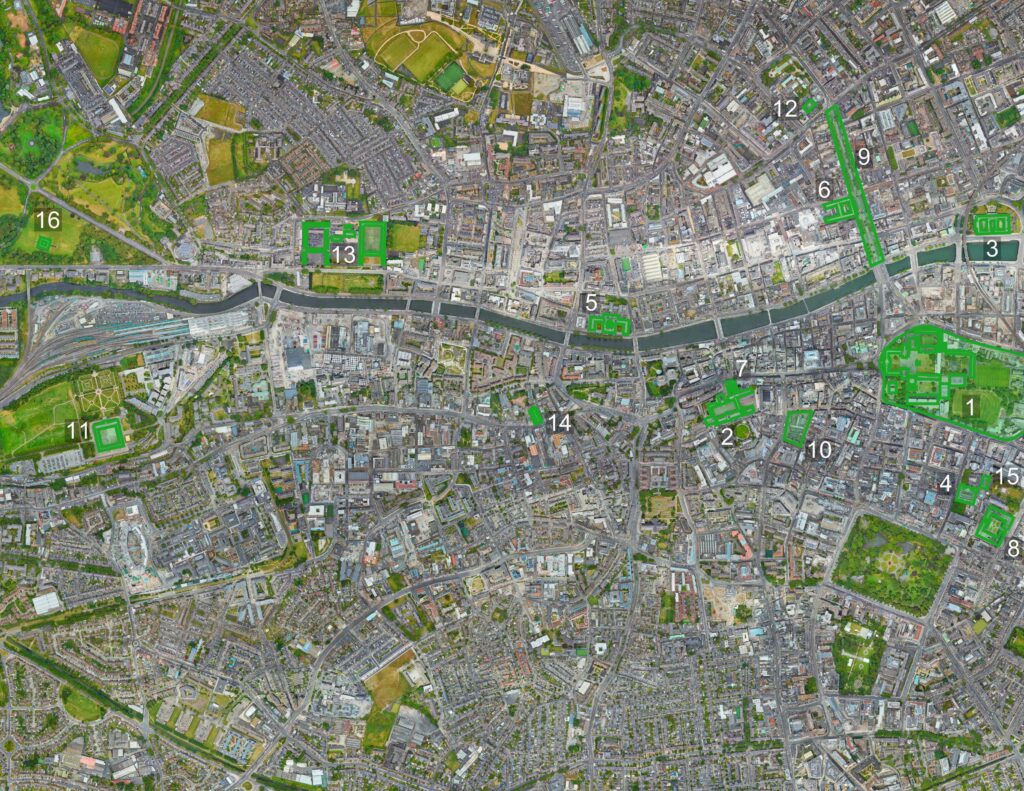
1. Trinity College
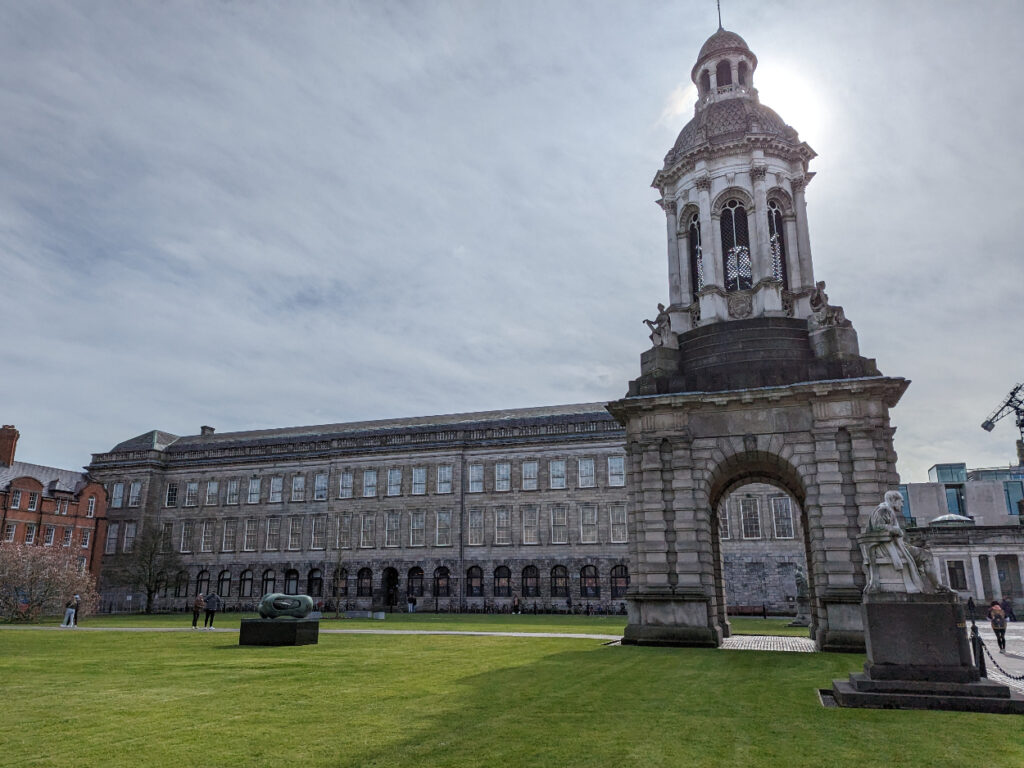
Trinity College is one of the most prestigious universities in all of Europe. It was originally founded by Queen Elizabeth I in 1592. Trinity College greatly expanded during the 18th & 19th centuries and became home to several of Dublin’s most notable buildings. The foreground of the image above shows the campus’s Campanile. The Campanile was completed in 1853 and is a type of bell tower. The design is mostly Neoclassical, but it also has details from Gothic & Baroque Revival Architecture. The background of the image above shows the Old Library Building at Trinity College – another of the campus’s many Neoclassical structures.
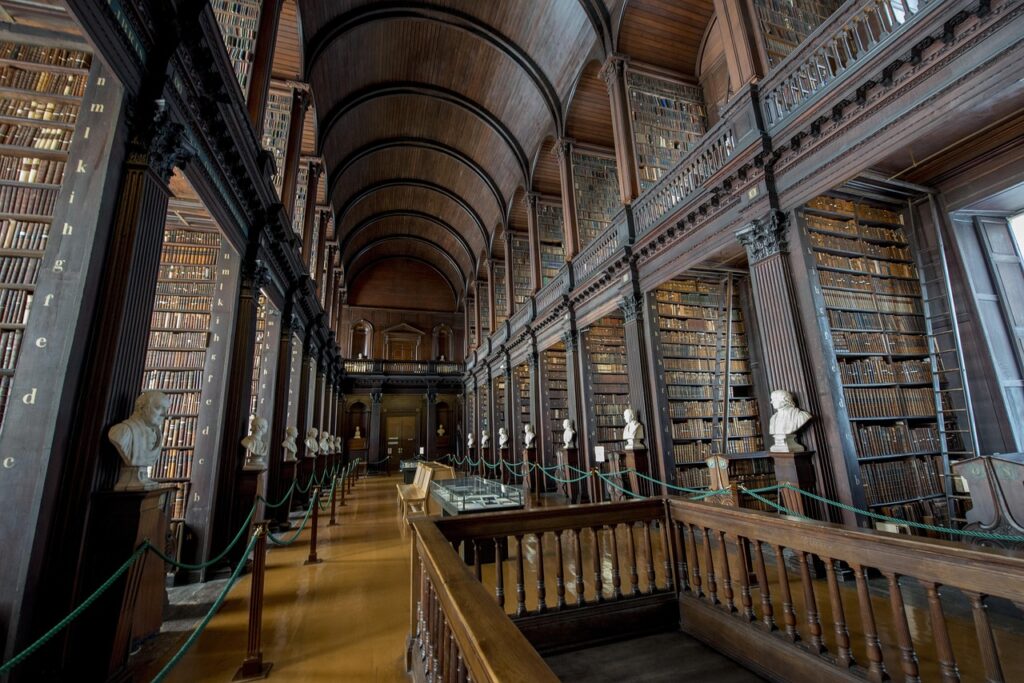
The Old Library Building houses one of the largest collections of books in all of Ireland. It also contains several notable artifacts from Irish history, such as the Trinity College Harp and the Book of Kells. The harp is a symbol of Ireland and was the inspiration for the Guinness Logo. The Book of Kells is a beautiful medieval manuscript containing some of the most incredible illustrations of the Gothic Age. Together, these artifacts make the Old Library of Trinity College one of Dublin’s most visited attractions.
2. Dublin Castle & Royal Chapel
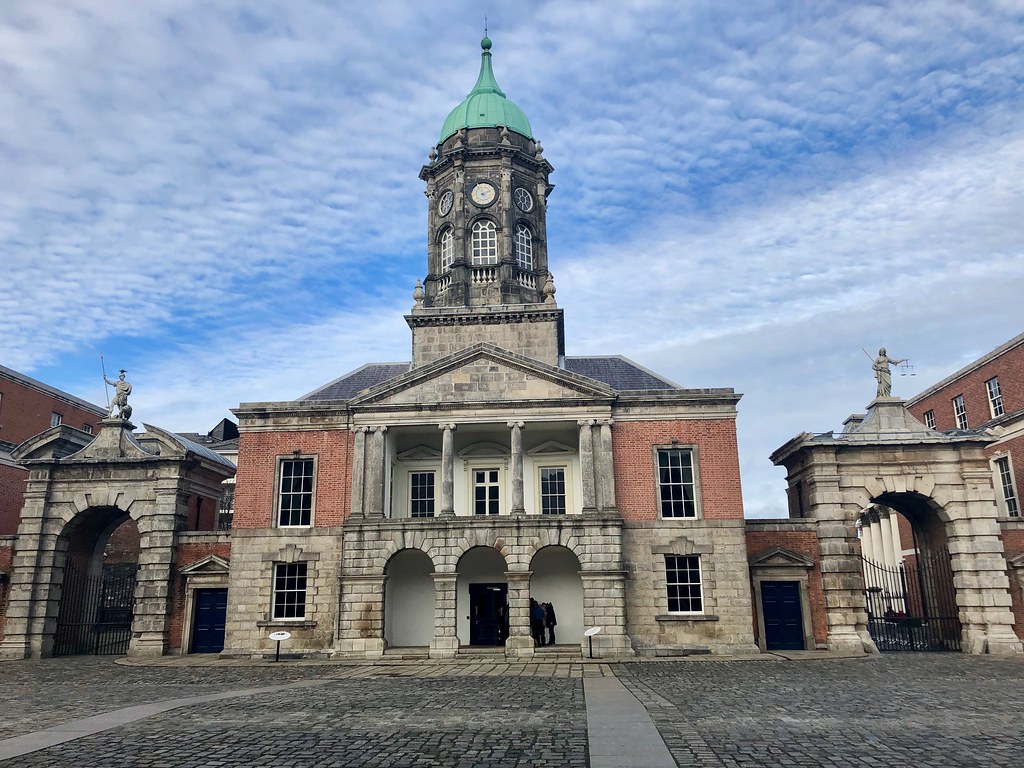
Dublin Castle originated as a Medieval Fortification constructed shortly after the Norman Invasion of Ireland. The building was continuously modified and expanded throughout history, and today it contains several additions designed in various Neoclassical & Revivalist Styles. The image above shows the Upper Castle Yard – an open square surrounded by buildings from the 18th century. These buildings were designed in the Neoclassical Style and contain some Renaissance Revival details. Dublin Castle was also outfitted with several Triumphal Arches connecting its buildings.
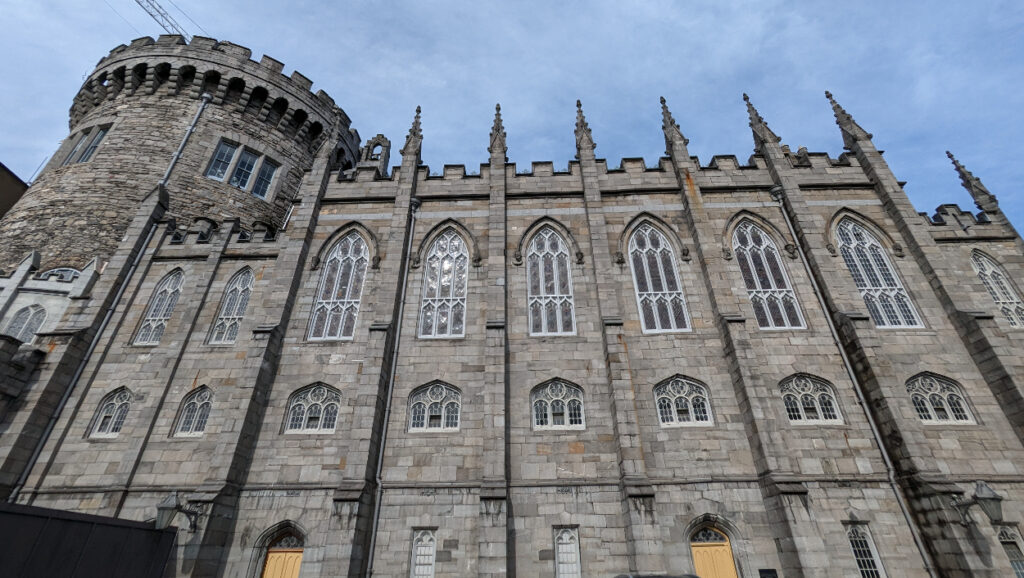
This image shows the Royal Chapel, which was added to Dublin Castle in the early 1800s. The chapel was designed in the Gothic Revival Style, and it contains many Gothic elements like pinnacles, stained glass, pointed arches, and Gothic tracery. The look of the chapel greatly resembles St. Patrick’s Cathedral and Christ Church Cathedral. Replicating older buildings was a key idea in the Revivalist Period, and it helped Dublin connect with its proud Medieval heritage.
3. The Custom House
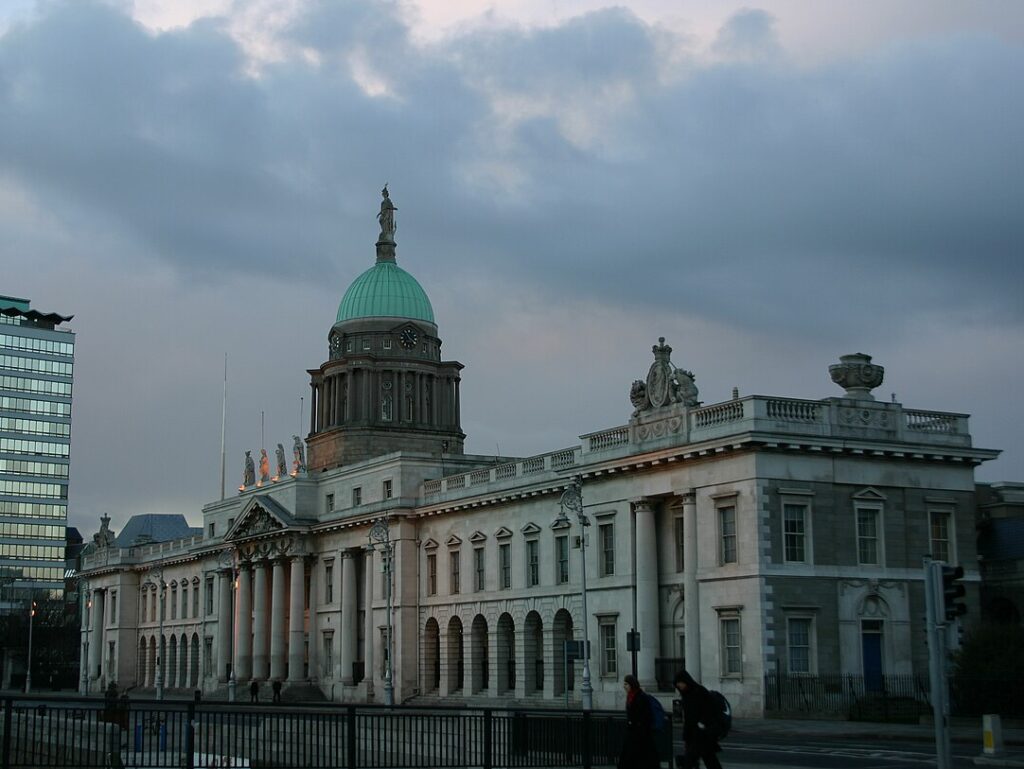
The Dublin Custom House is a large, prominent building overlooking the banks of the River Liffey. It was completed in 1791 and designed in the Neoclassical Style. At the time of its completion, the building was very controversial, and many people opposed its construction. This was because the Custom House stood as a symbol of English Rule over Ireland, and it assisted with the taxation on Irish trade and commerce.
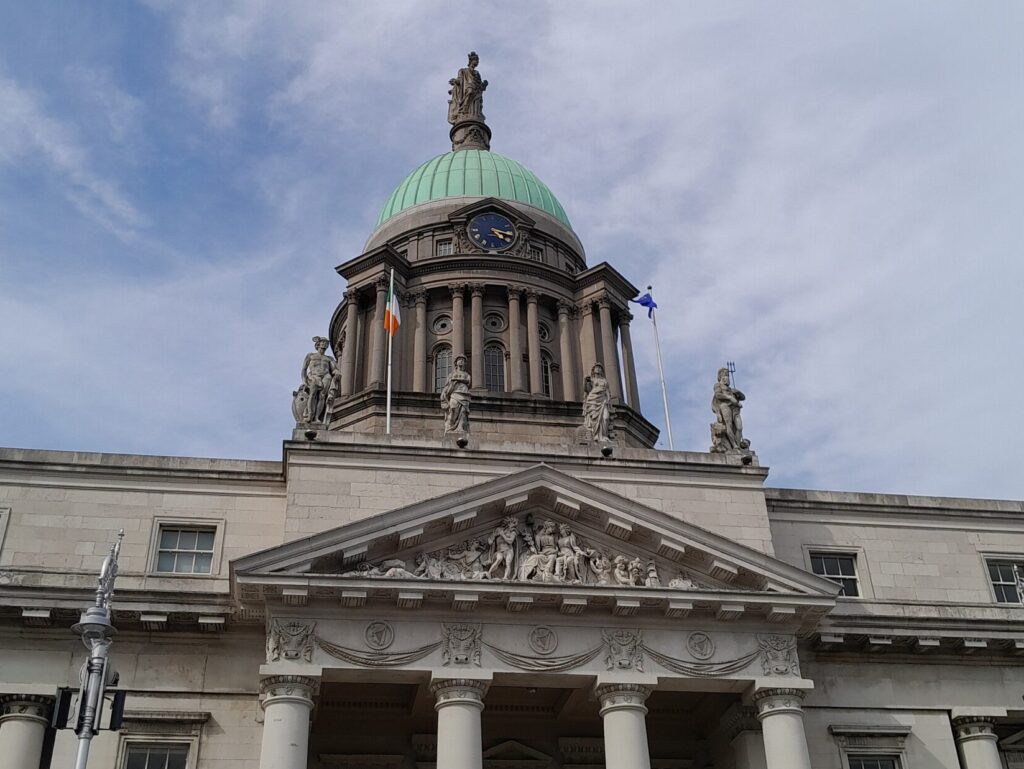
The Dublin Custom House contains many of the key characteristics of Neoclassical Architecture. In the image above, you can see the building’s temple-front facade, which has a pediment over four columns. There is also a large copper-clad dome over the center of the building, which is decorated with Corinthian columns and Classical Statues. Today, the building houses offices for various components of the local government.
4. National Museum of Ireland
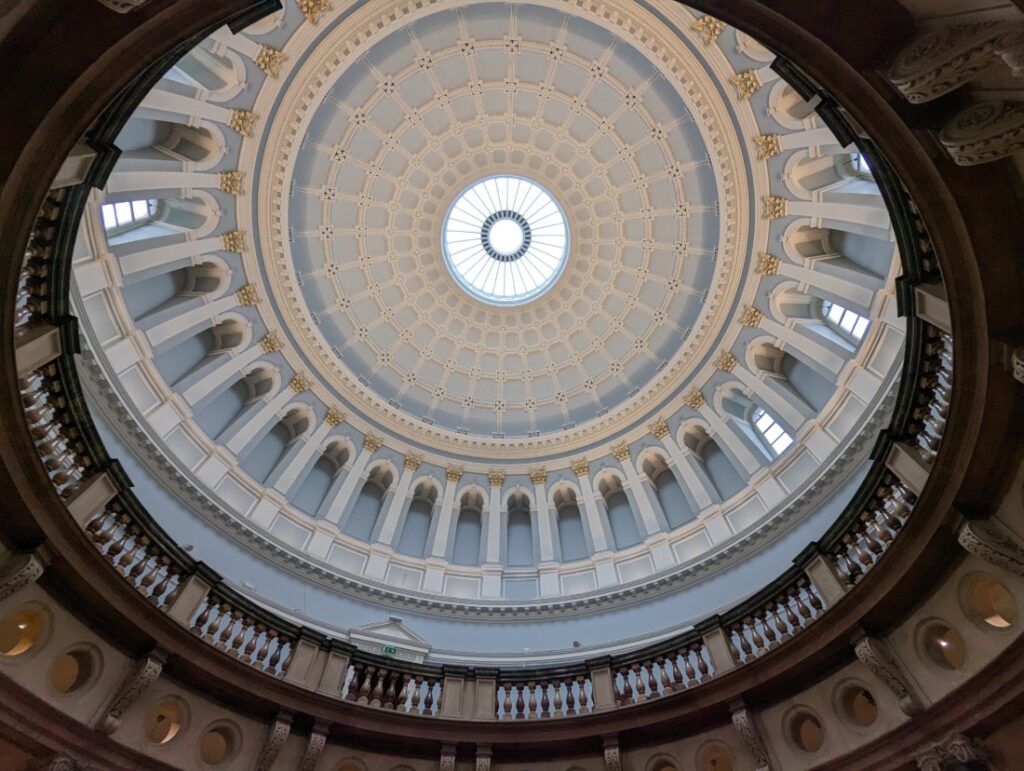
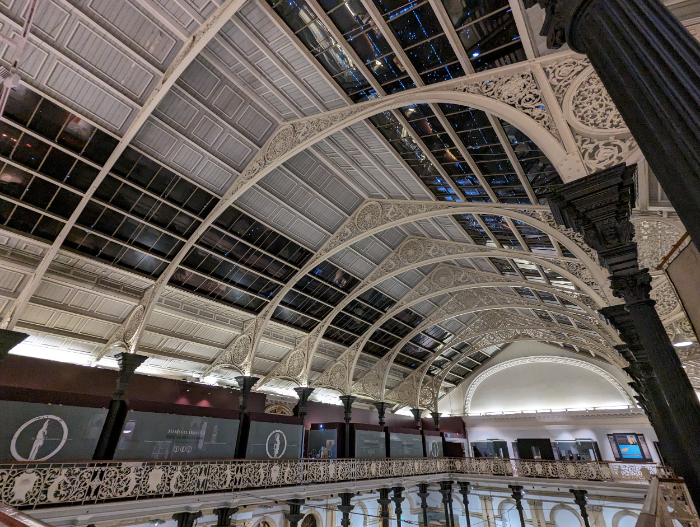
The National Museum of Ireland is one of Dublin’s greatest museums. It contains a variety of artifacts relating to Irish history, including tools from the Stone Age and remnants of Viking longships. The exhibits are housed in a great example of Neoclassical Architecture that was completed in 1890. The building also incorporates a few Beaux Arts elements, such as iron structural framing and glass skylights
5. Four Courts
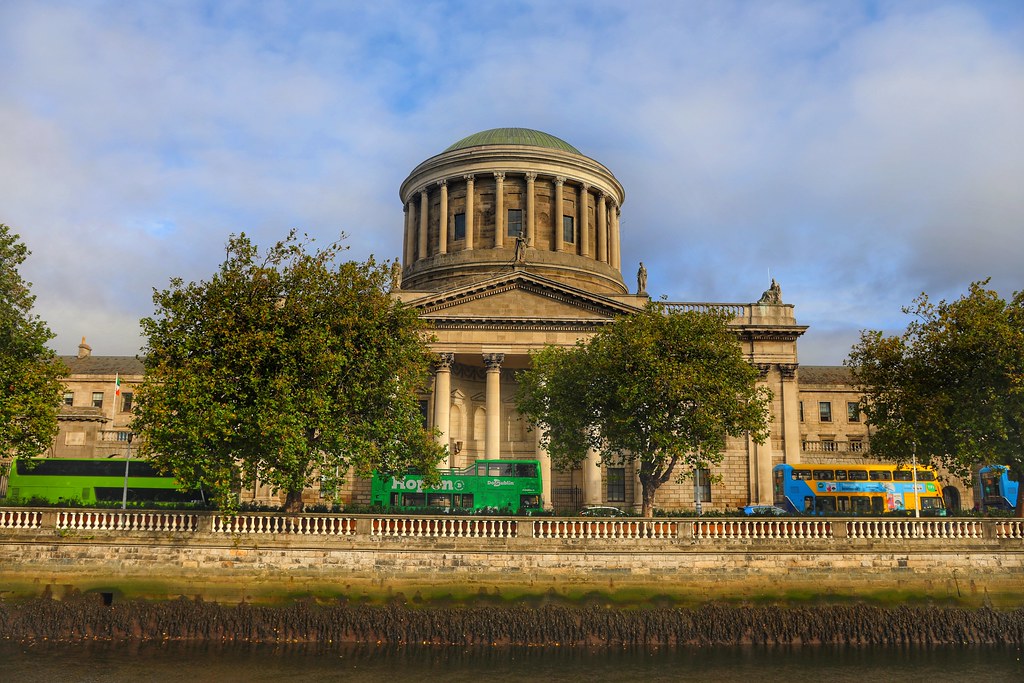
The Four Courts Building is another iconic work of Neoclassical Architecture in Central Dublin. The building holds several of Ireland’s main courts and was completed in 1802. The Four Courts Building has several distinct Neoclassical details, like a symmetrical facade and a central dome. In 1922, the Four Courts Building was famously the focal point of the Battle of Dublin during the Irish Civil War. During the conflict, IRA forces clashed with National Army Forces, leading to the destruction of most of the structure. The Four Courts Building was eventually rebuilt following the war.
6. The General Post Office Building
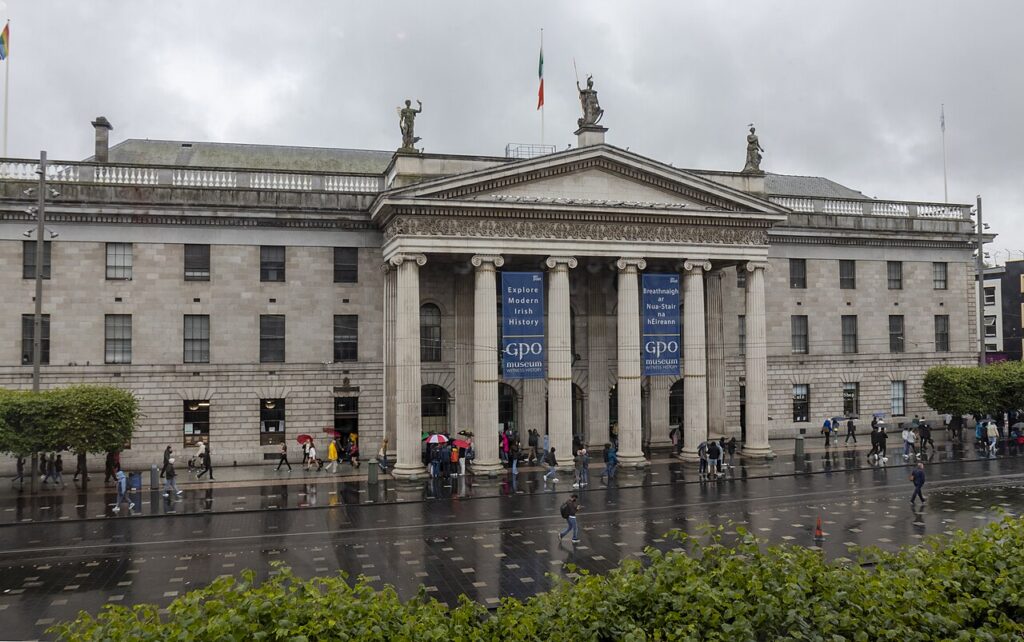
The General Post Office Building is a work of Neoclassical Architecture located along Dublin’s O’Connell Street. Post offices were important institutions during the 1800s, and many impressive post office buildings can be found throughout Western Europe and North America. The General Post Office Building was completed in 1818 and held the post office up until the 21st century. Today, the building is known as the GPO, and it contains a museum dedicated to the Easter Rising and subsequent conflicts.
7. Dublin City Hall
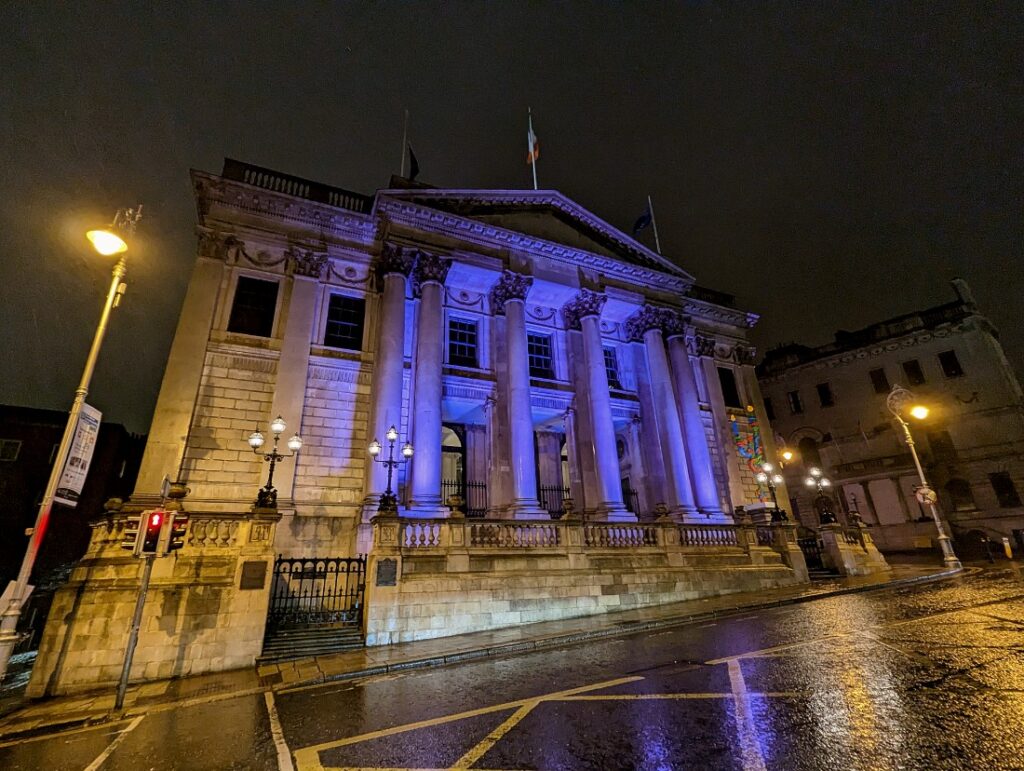
Dublin City Hall is a prominent government building located right next to Dublin Castle. It houses offices for the local government and was completed in 1779. The building has many details from Neoclassical Architecture, including Corinthian Columns, Pediments, and a dome. The exterior is also completely symmetrical and made entirely from white stone. The image above shows Dublin City Hall at night, when its white facade is lit with varying colors.
8. Department of the Taoiseach Building

Dublin’s Department of the Taoiseach is located in a large building on Merrion Street. The building was constructed in the early 1900s, and it combines elements from Neoclassical and Baroque Revival Architecture. Neoclassicism is extremely popular with world governments. The UK and the United States, in particular, constructed many Neoclassical buildings in an effort to align their governments with those of the Ancient Greeks and Romans.
9. Facades of O’Connell Street
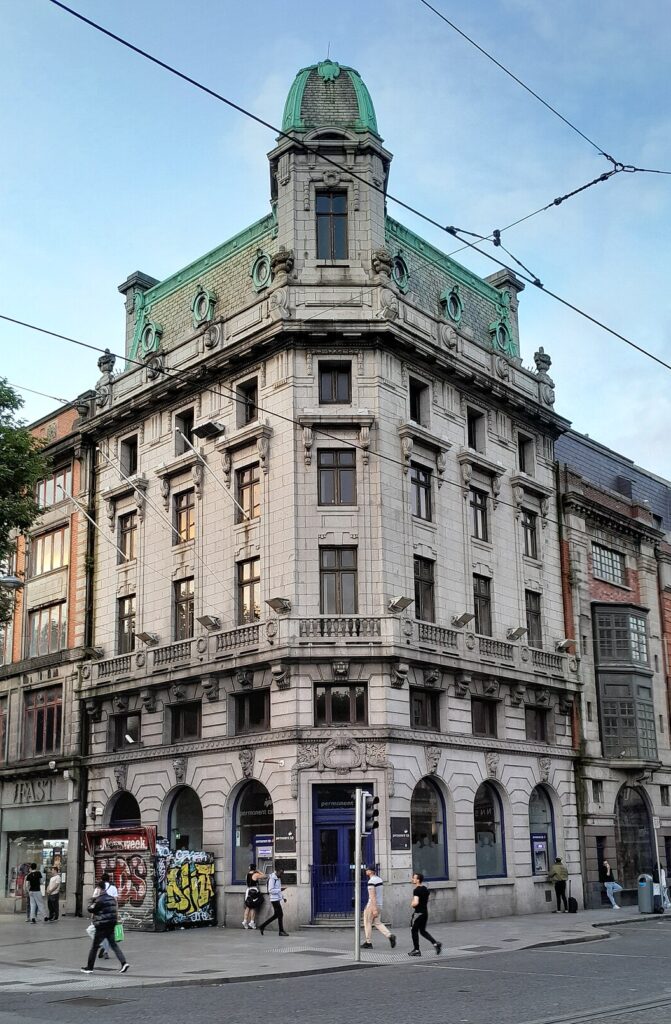
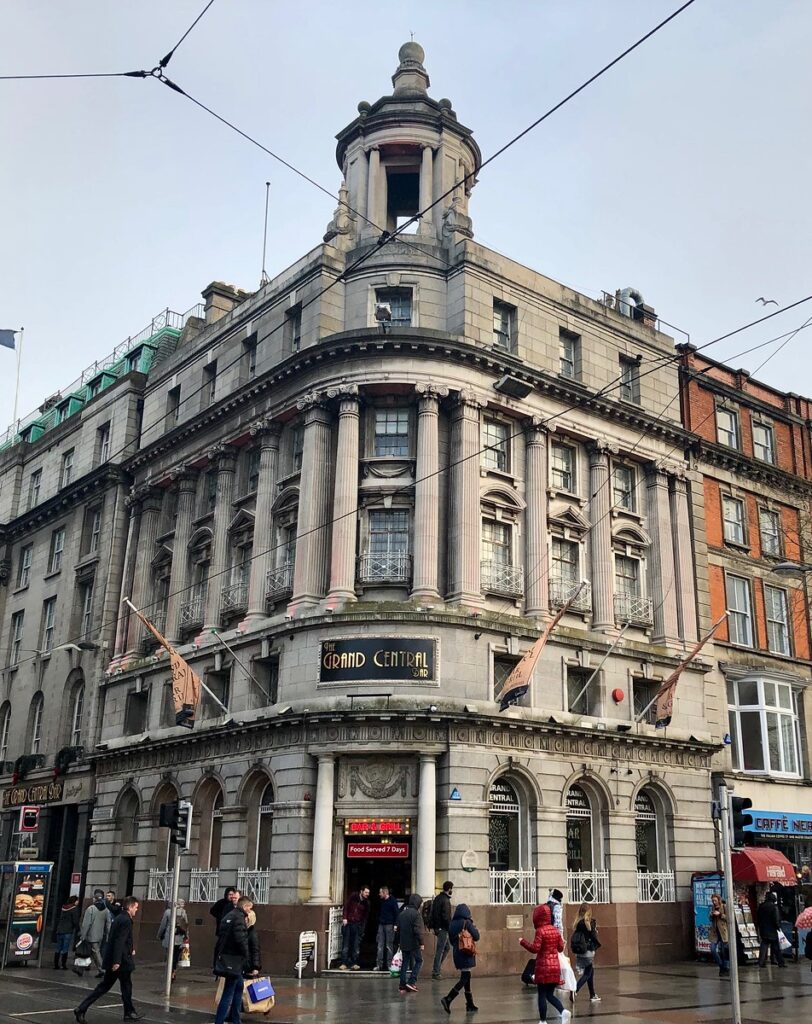
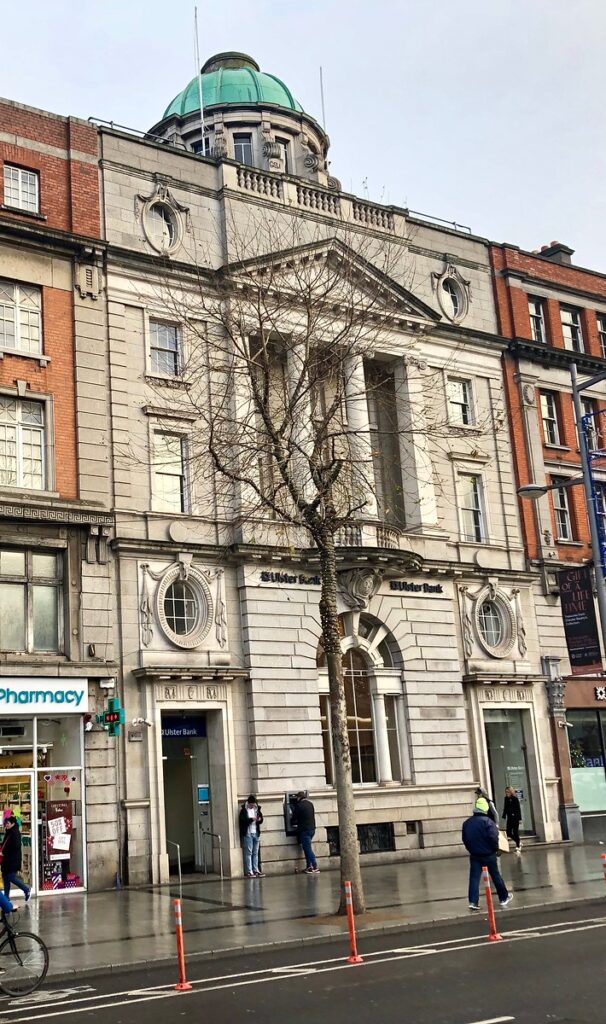
O’Connell Street is a prominent avenue that runs north to south. It connects Dublin’s northern neighborhoods with the city center and the River Liffey. The street was mostly built up during the 19th century and has many row houses designed in various Revivalist styles. The left image above shows a building at the corner of O’Connell Street and Abbey Street, which combines Neoclassical and Beaux Arts details. The right image shows a building at the start of O’Connell Street, across from the O’Connell Monument.
10. George’s St. Arcade
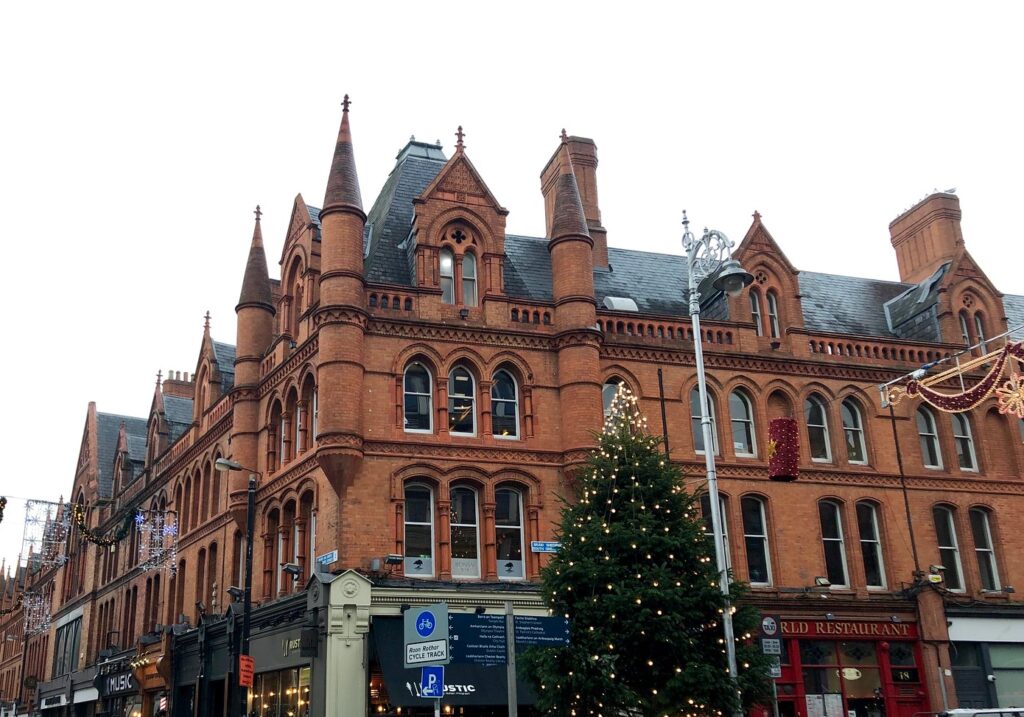
George’s St. Arcade is a mixed-use building in Dublin. It contains a variety of restaurants and retail spaces on the ground floor, with offices and apartments on the upper floors. The arcade was constructed in the 1870s and overlooks George’s Street, not far from Dublin Castle and Dubh Linn Green. The George’s St. Arcade was designed in an eclectic Revivalist style, which blends elements from Romanesque, Gothic, and Norman Architecture.
11. Irish Museum of Modern Art
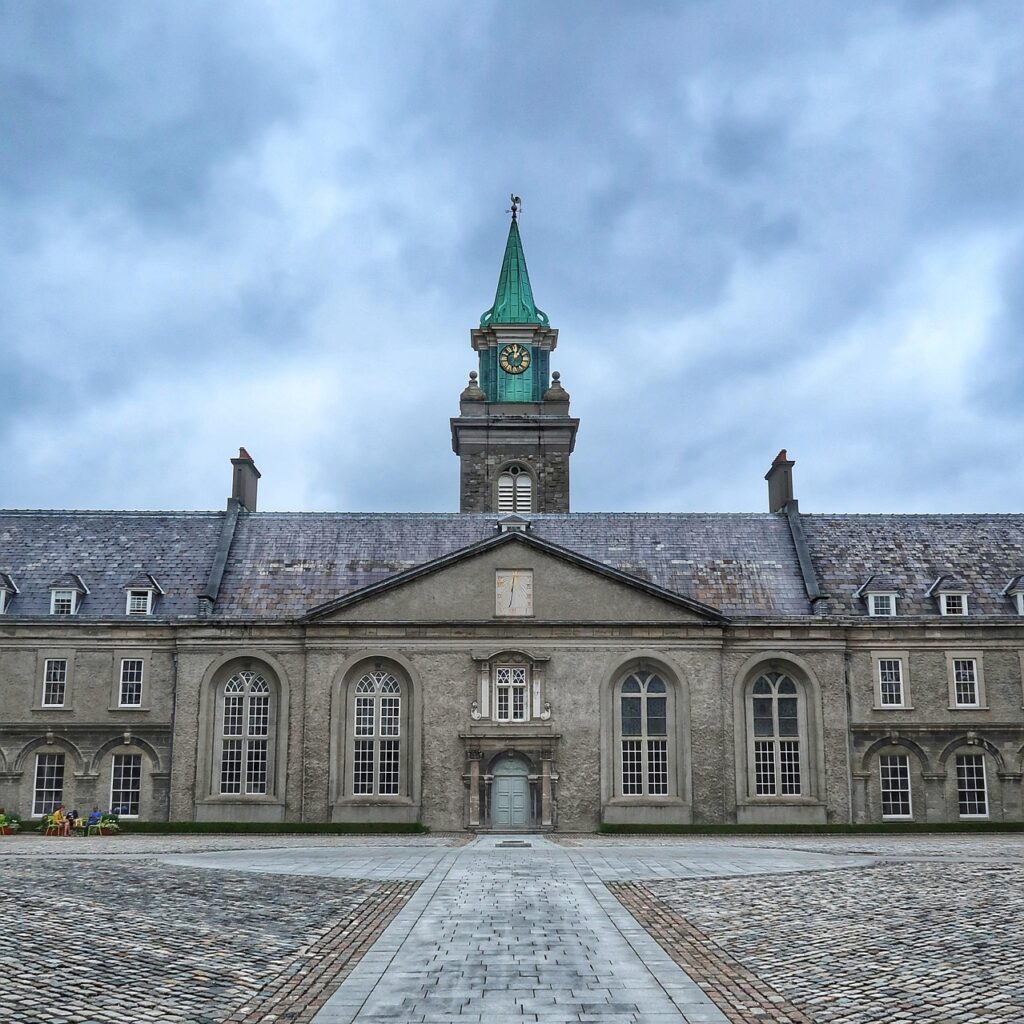
The Irish Museum of Modern Art is another great art institution in modern-day Dublin. The museum houses numerous works of contemporary art and also hosts rotating exhibits. The building was originally known as the Royal Hospital Kilmainham, and it was constructed in the late 1600s. This makes it one of the oldest Neoclassical buildings in all of Ireland.
12. Rotunda Hospital
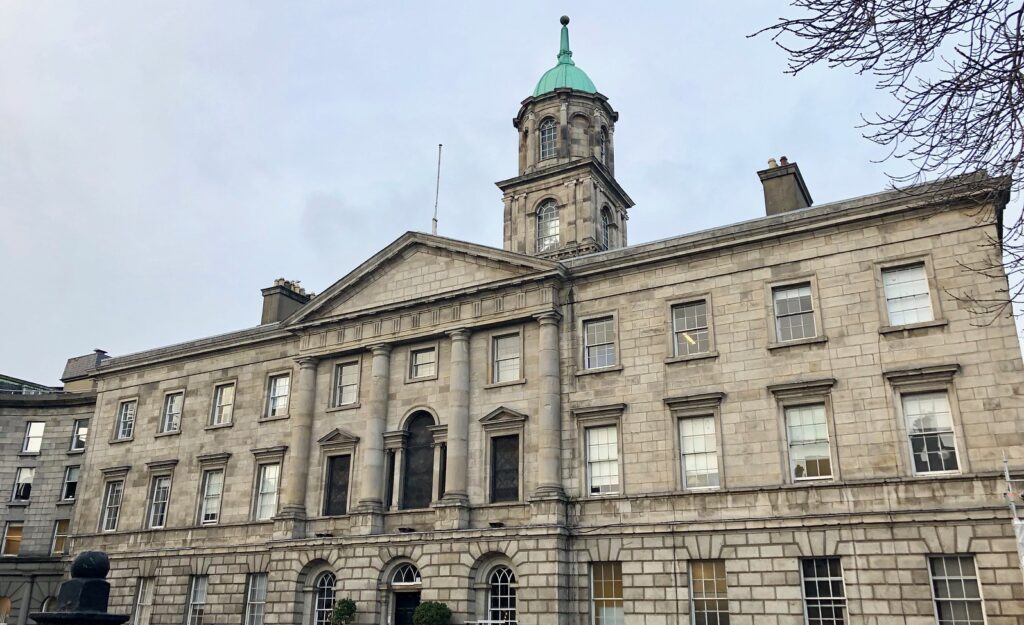
Located on the northeastern edges of central Dublin, Rotunda Hospital is an institution established in 1745. The hospital is housed in a work of Neoclassical Architecture, dating from the mid-18th century. Rotunda Hospital has many Neoclassical elements, including a symmetrical facade, a central cupola, pediments, and Doric Columns. Today, Rotunda Hospital still serves its original purpose, and it is one of the most renowned maternity centers in all of Ireland.
13. Collins Barracks
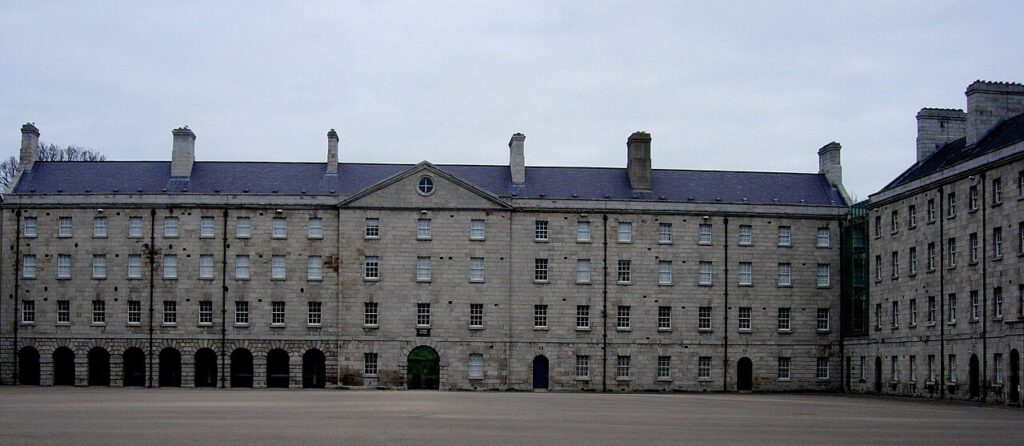
The Collins Barracks is another Neoclassical Building constructed during the peak of British control in Dublin. The earliest building dates to 1702, but the barracks was expanded several times during the 18th & 19th centuries. The Collins Barracks helped to assert British Imperial dominance on the island, and it housed a large number of troops. Nowadays, the building is open to the public, and it contains a division of the National Museum of Ireland.
14. John’s Lane Church
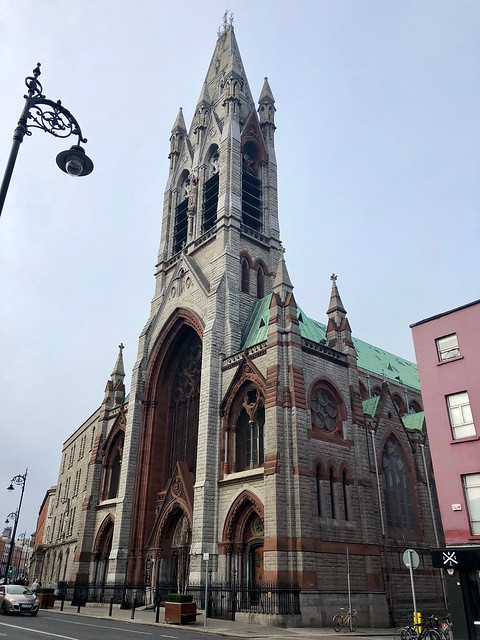
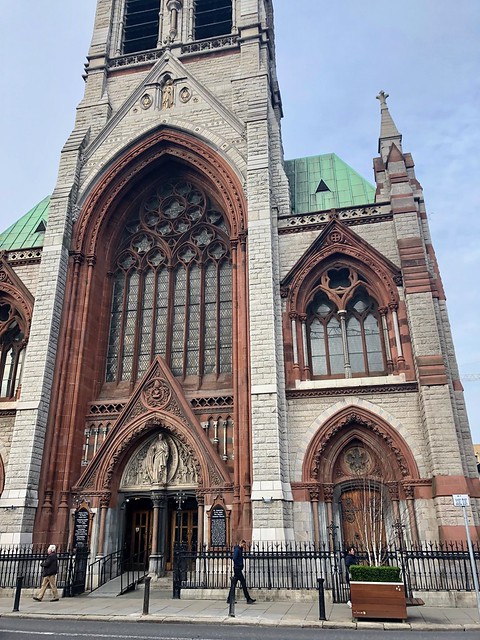
John’s Lane Church is one of the greatest examples of Gothic Revival Architecture in Dublin. The church opened in 1874, and its iconic tower is one of the tallest structures in this part of the city. The Neogothic design was meant to replicate Dublin’s other prominent Gothic Churches, such as St. Patrick’s Cathedral. The facade of John’s Lane Church contains towering pointed arches filled with intricately carved Gothic tracery.
15. Leinster House
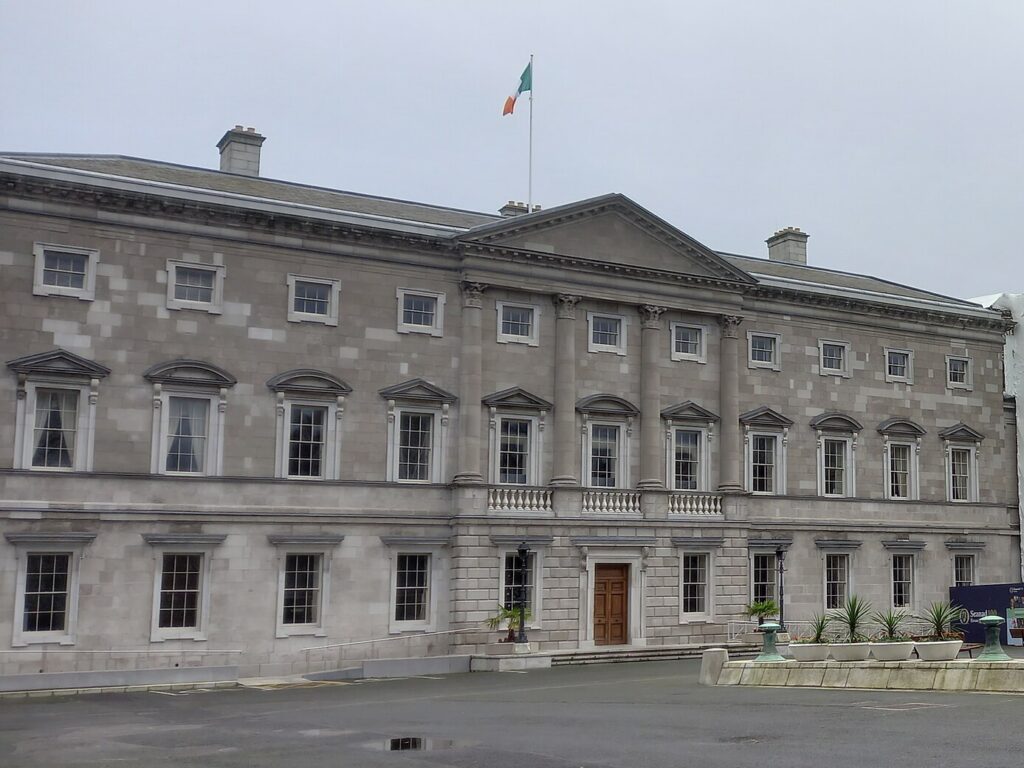
Leinster House is another work of Neoclassical Architecture in Dublin, dating from the Georgian Period. It was constructed during the mid-1700s as the inner-city home for the Duke of Leinster. Today, Leinster House holds the parliament of Ireland, or the Oireachtas. It now sits among many other prominent Revival-style buildings, such as the National Museum of Ireland and the National Library of Ireland.
16. Wellington Monument
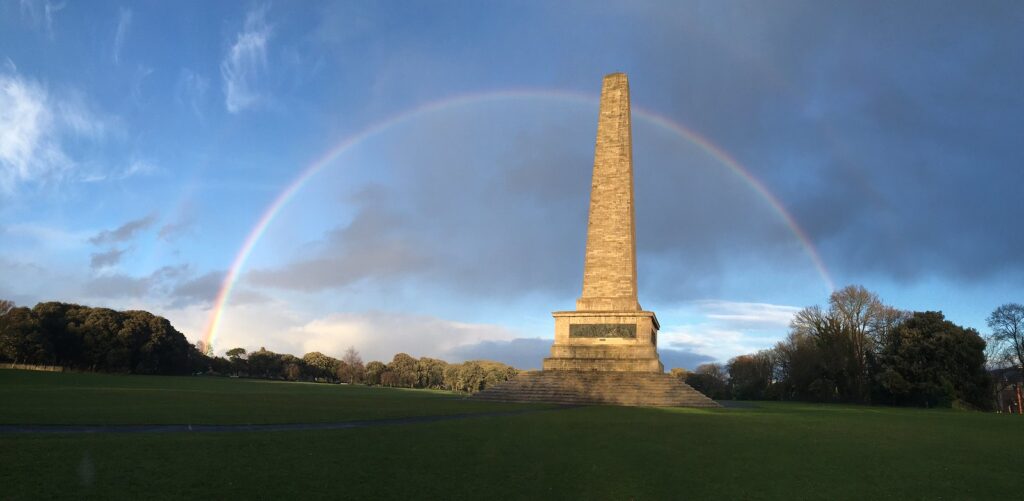
The Wellington Monument is an obelisk that sits within Dublin’s Phoenix Park. It commemorates Arthur Wellesley, 1st Duke of Wellington – a British general who won several notable battles against Napoleon. The Revival Movement focused on recreating the architecture of the past. Many ancient monuments like Victory Columns, Triumphal Arches, and Obelisks were constructed throughout the 19th century to commemorate various people and occasions.
Like Architecture of Cities? Sign up for our mailing list to get updates on our latest articles and other information related to Architectural History.
Modern Architecture in Dublin
In the aftermath of the Easter Rising and the conflicts that followed, Dublin emerged as a vibrant and prosperous modern city. Dublin is home to many impressive contemporary buildings and pieces of infrastructure. The city has a thriving economy and is home to some of Ireland’s largest corporations. Dublin has a wide variety of museums and cultural institutions, in addition to unique restaurants and popular spots for nightlife like the famous Temple Bar. Today, Dublin is also an up-and-coming tourist destination, and many people include the city on their Irish travel itineraries.
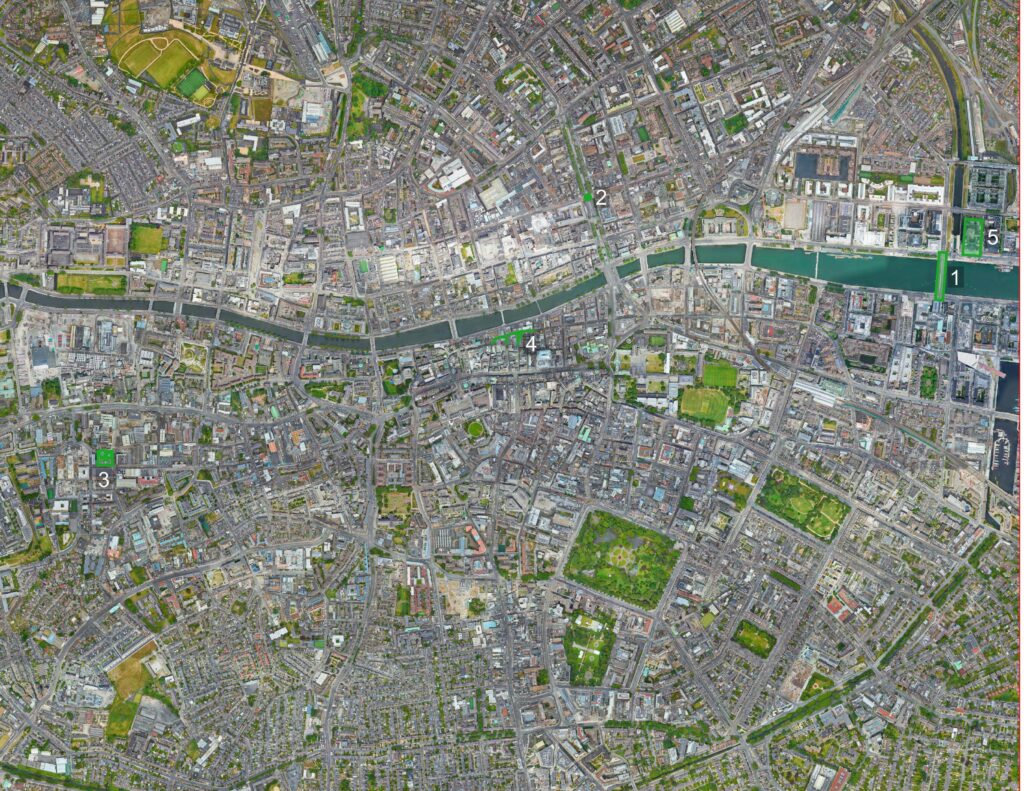
1. Samuel Beckett Bridge
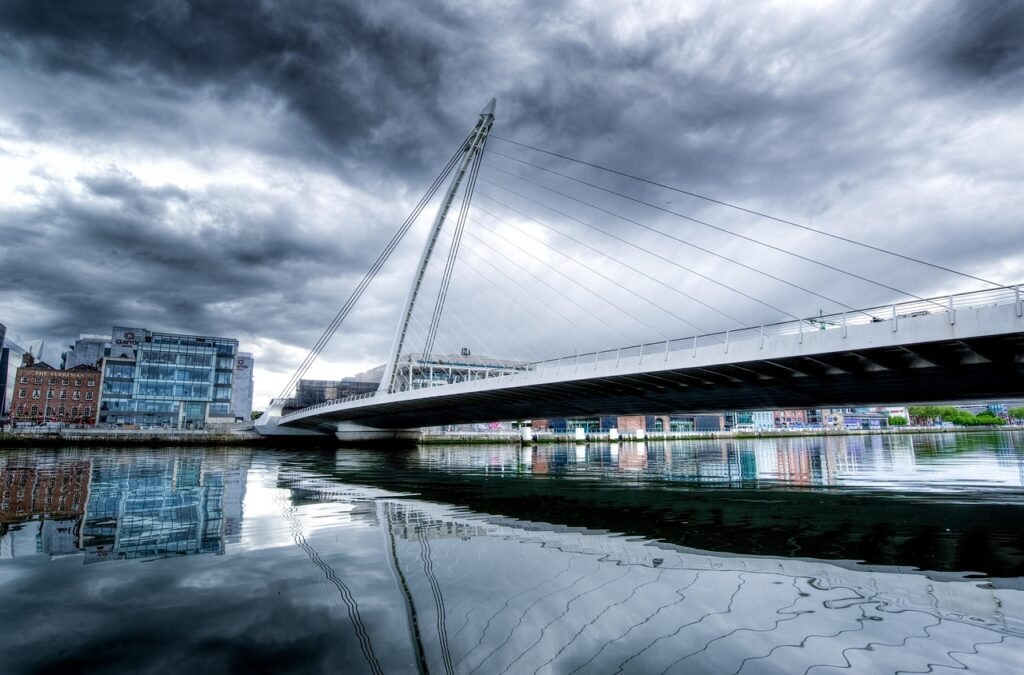
Samuel Beckett Bridge is the second most eastwardly crossing point of the River Liffey. It’s a great example of Modern Architecture in Dublin. The bridge was constructed from 2007 to 2009 and designed by the famous engineer & architect, Santiago Calatrava. Samuel Beckett Bridge is a type of Cable-stayed bridge, with a single main support member. The design is typical of the style of Calatrava, who has designed similar bridges in cities like Valencia, Seville, and Buenos Aires.
2. The Spire
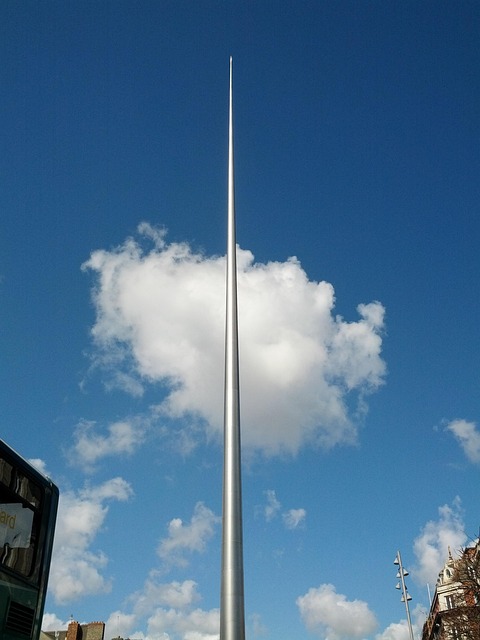
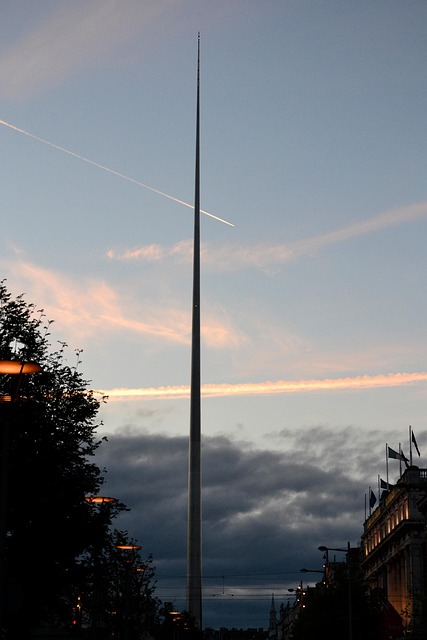
In 1809, the English constructed a large Triumphal Column in the middle of O’Connell Street in Central Dublin. This monument stood as a testament to English Rule, and was not liked by the Irish people. In 1966, forces from the Irish Republican Army detonated a bomb and destroyed the English-made structure. Eventually, in 2002, on the same spot as the previous column, the city of Dublin built “The Spire” – a large stainless steel monument commemorating the struggle for Irish Independence.
3. Guinness Storehouse
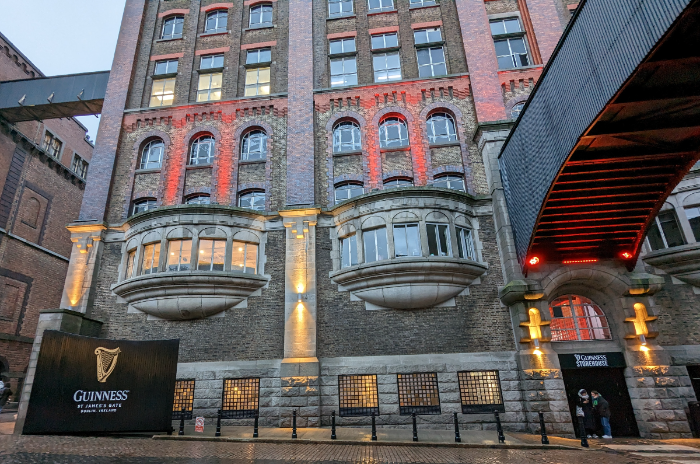
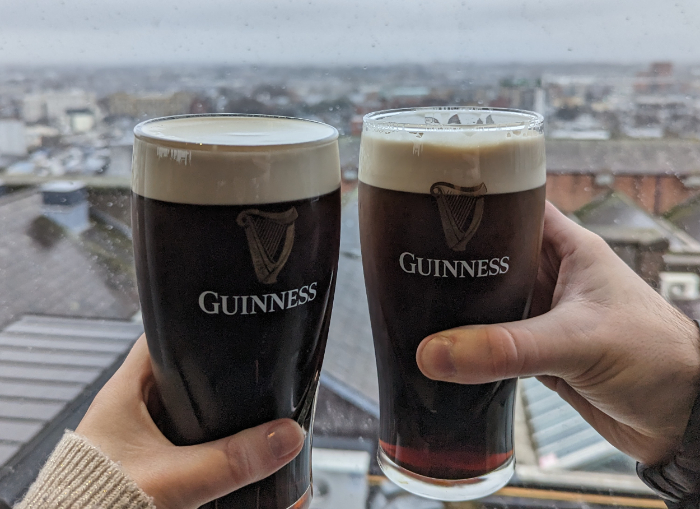
The Guinness Storehouse is one of the most popular tourist destinations in all of Ireland. It’s located in an area of Dublin known as St. James’s Gate. The storehouse tour starts at the base of the building with a series of exhibits and installations on Guinness and how it’s made. The tour ends at the top of the building, where you can stop at the Gravity Bar – a glass-enclosed rooftop bar that sells Guinness with a view of all of Dublin.
4. Temple Bar Area
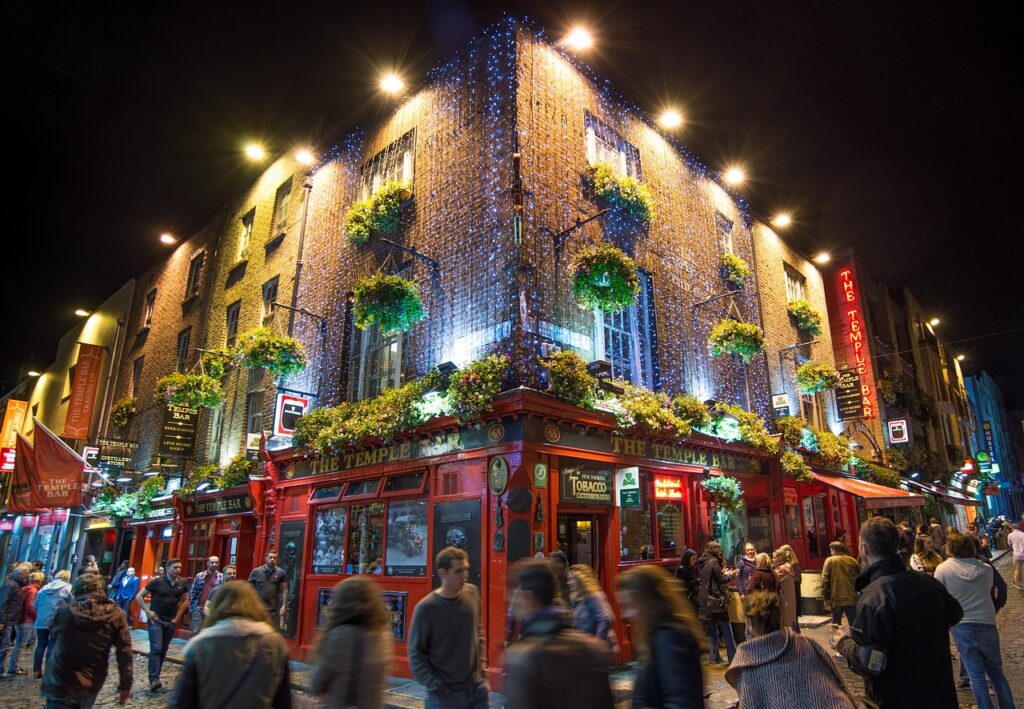
Temple Bar is another popular drinking spot located in central Dublin. The area is centered around Temple Bar, just south of the banks of the River Liffey. Temple Bar is filled with buildings mostly from the 19th century, and it’s the liveliest area in Dublin. The Temple Bar Area is famous for its nightlife, and many of the businesses are decorated with flashy lights and signs.
5. Dublin Convention Center
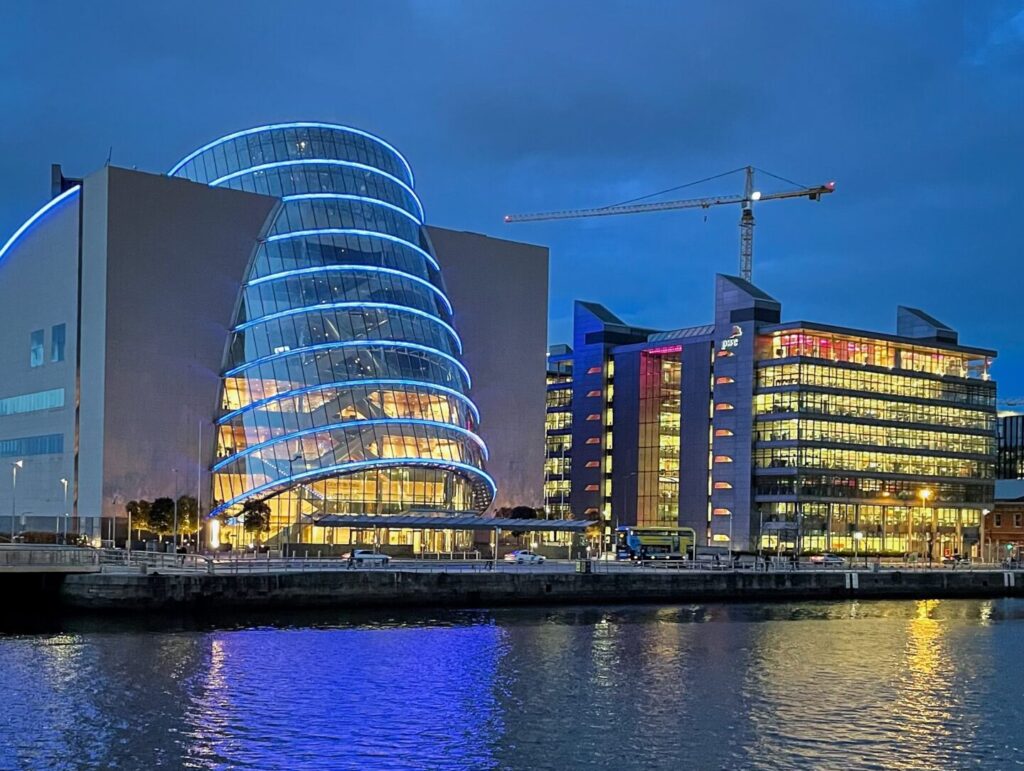
The Convention Center is another great example of modern architecture in Dublin. The building sits right across from the River Liffey next to the Samuel Beckett Bridge. Dublin Convention Center opened its doors in 2010 and has become the city’s most important exhibition space. It hosts periodic events emphasizing the various industries thriving in modern-day Ireland.
Areas of Dublin
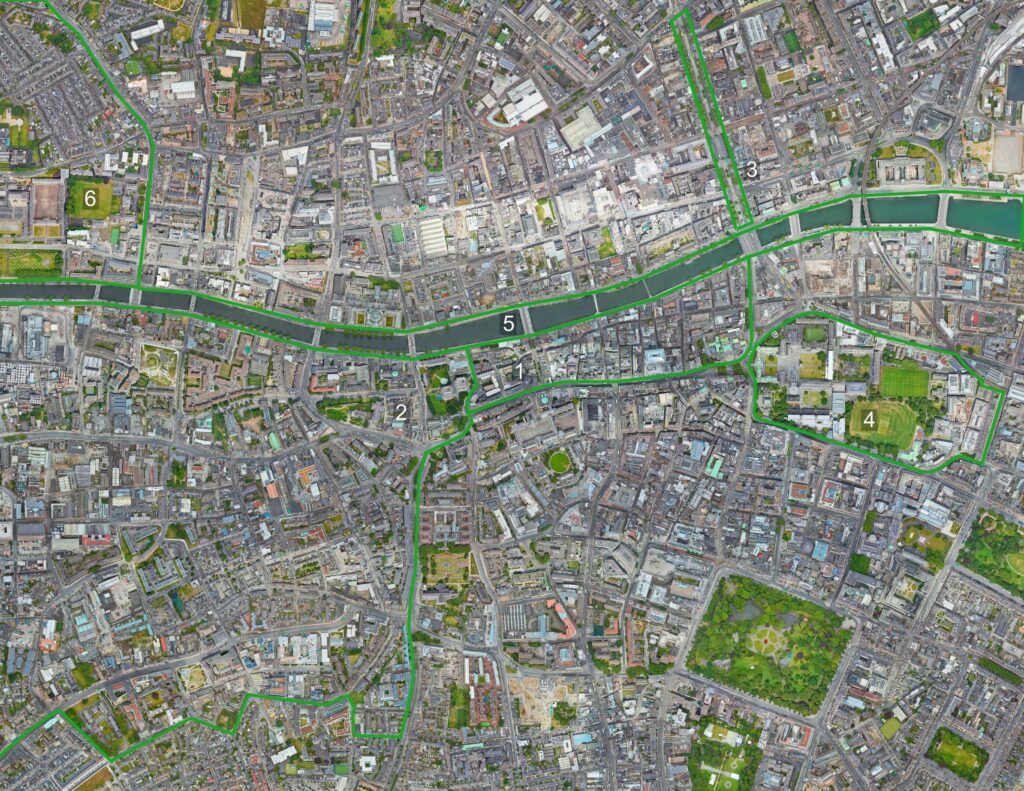
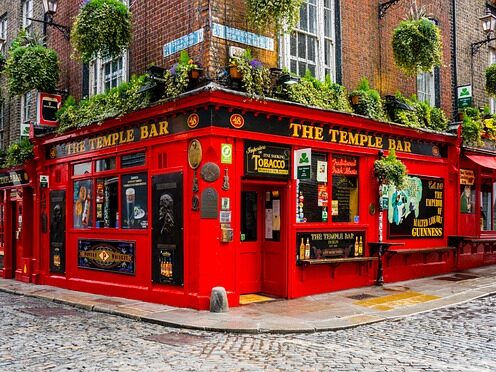
1. Temple Bar
Temple Bar is the most touristy area in Dublin. It’s a small neighborhood that is centered around Temple Lane Street. This area is filled with bars, nightclubs, restaurants, and other commercial businesses.
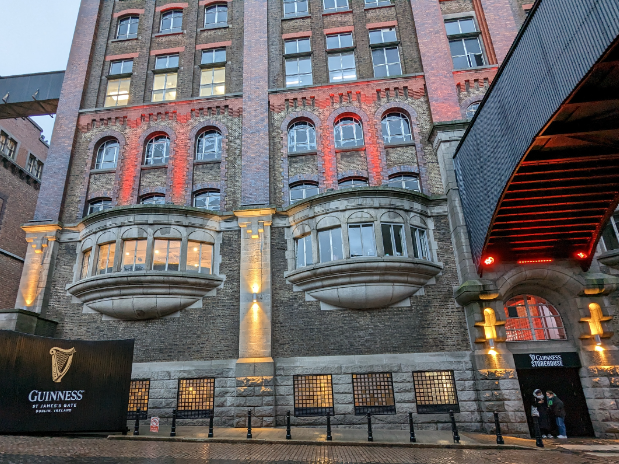
2. The Liberties
The Liberties is a large neighborhood in Dublin, located on the south bank of the River Liffey. The Liberties contains an assortment of streets and squares, and it is both commercial and residential. This area contains many important sites like the Guinness Storehouse.
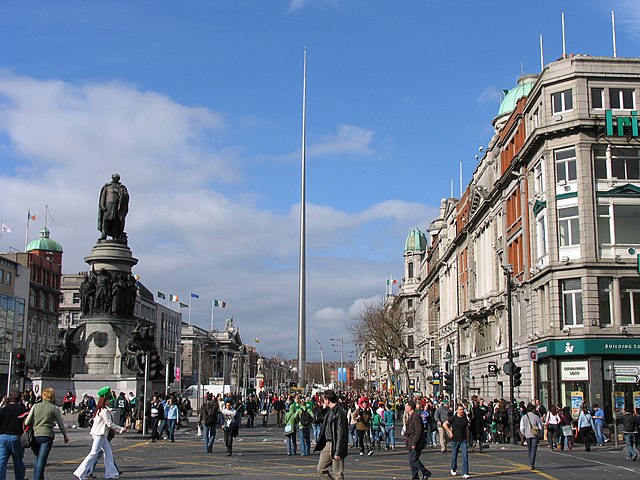
3. O’Connell Street
O’Connell Street is a north-south roadway that sits on the Northern bank of the River Liffey. The street was built up during the 19th century and contains some of the finest townhouses in Dublin. O’Connell Street is also home to the Spire, a modern structure that looks like a needle jutting out from the earth.
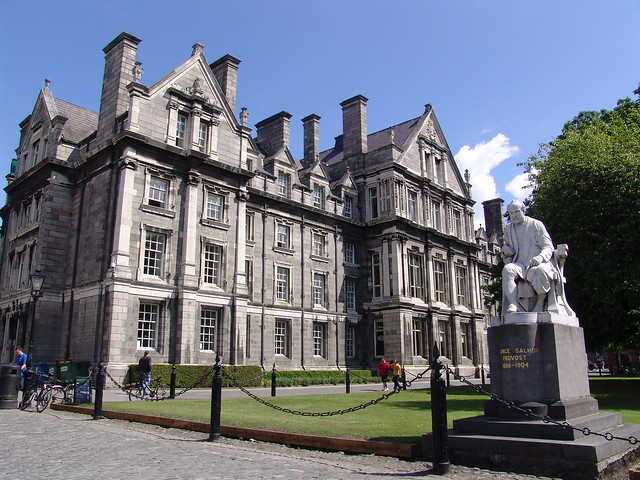
4. Trinity College
Trinity College is an entire campus situated on the Eastern side of Dublin’s city center. Trinity College is an active school attended by thousands of students, but it’s also one of the most visited sites in the entire city. Trinity College has one of the finest campuses of any university, and it’s filled with several impressive Neoclassical buildings.
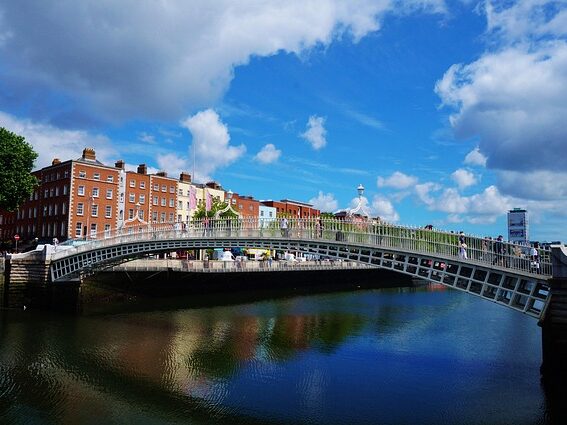
5. River Liffey
The River Liffey cuts through the center of Dublin and essentially divides the city in half. Many of the city’s major sites, like Dublin Castle, St. Patrick’s Cathedral, and Trinity Church, are all located on the river’s southern side. The image above shows the Ha’Panney Bridge, which crosses the river in central Dublin.
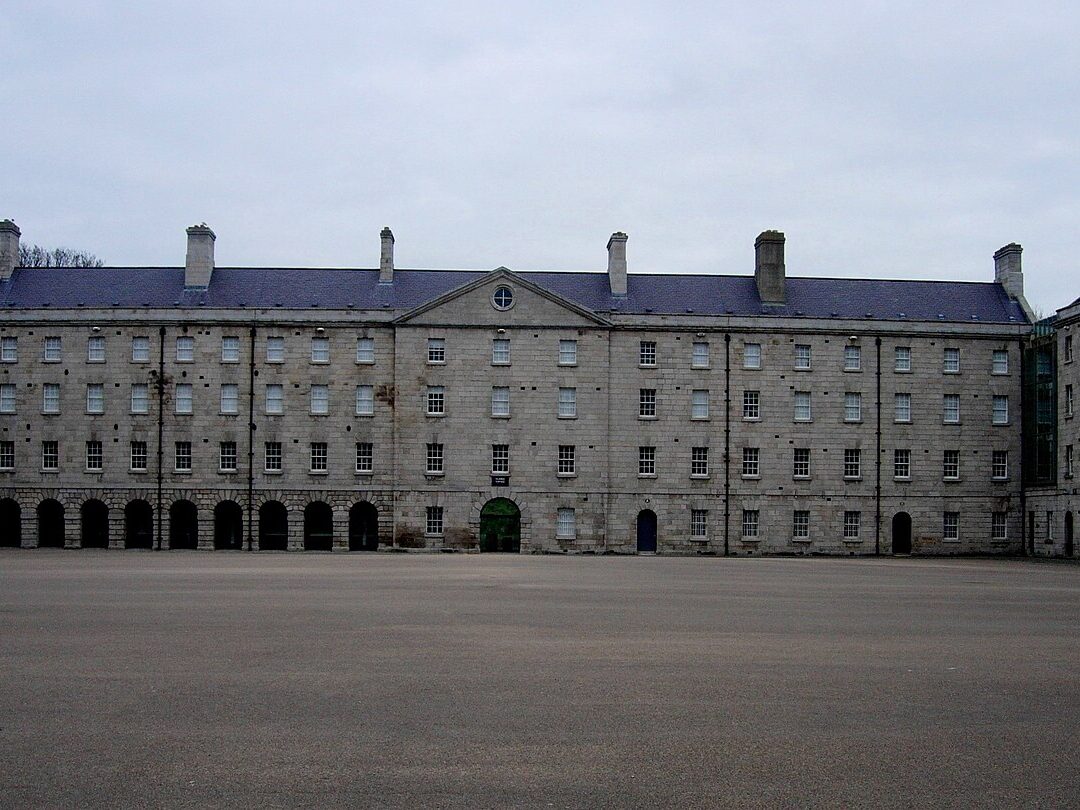
6. Stoneybatter
Stoneybatter is a neighborhood on the north bank of the River Liffey, on the western edge of town. It’s a very residential neighborhood, but it does contain some major sites, including the Collins Barracks. The neighborhood also sits at the edges of Phoenix Park.
Architecture of Dublin: In Review
Dublin is an incredible city filled with many impressive works of architecture. Dublin has several notable Gothic and Romanesque buildings, dating back to the early Anglo-Norman period. The city also contains lots of 18th & 19th century buildings, dating from when Dublin was one of the most populous cities in the British Empire. After centuries of outside rule, Ireland gained its independence in 1921, and Dublin became the nation’s capital. Today, it is a bustling modern metropolis, filled with countless bars, restaurants, museums, and monuments.
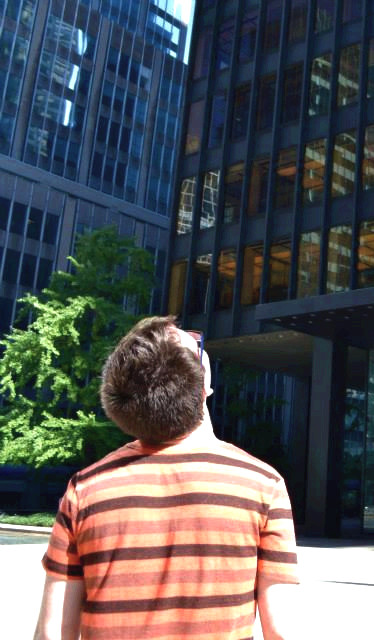
- About the Author
- Rob Carney, the founder and lead writer for Architecture of Cities has been studying the history of architecture for over 15 years.
- He is an avid traveler and photographer, and he is passionate about buildings and building history.
- Rob has a B.S. and a Master’s degree in Architecture and has worked as an architect and engineer in the Boston area for 10 years.
Like Architecture of Cities? Sign up for our mailing list to get updates on our latest articles and other information related to Architectural History.
